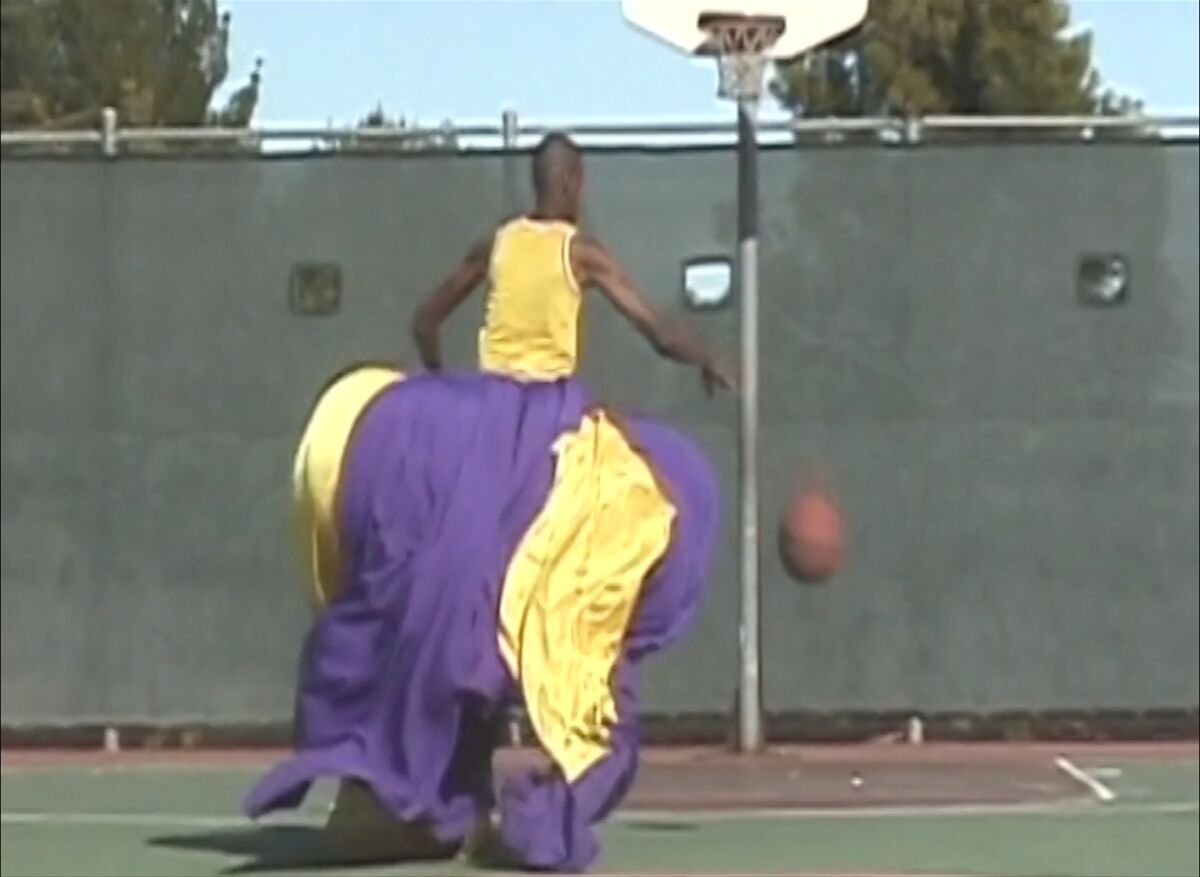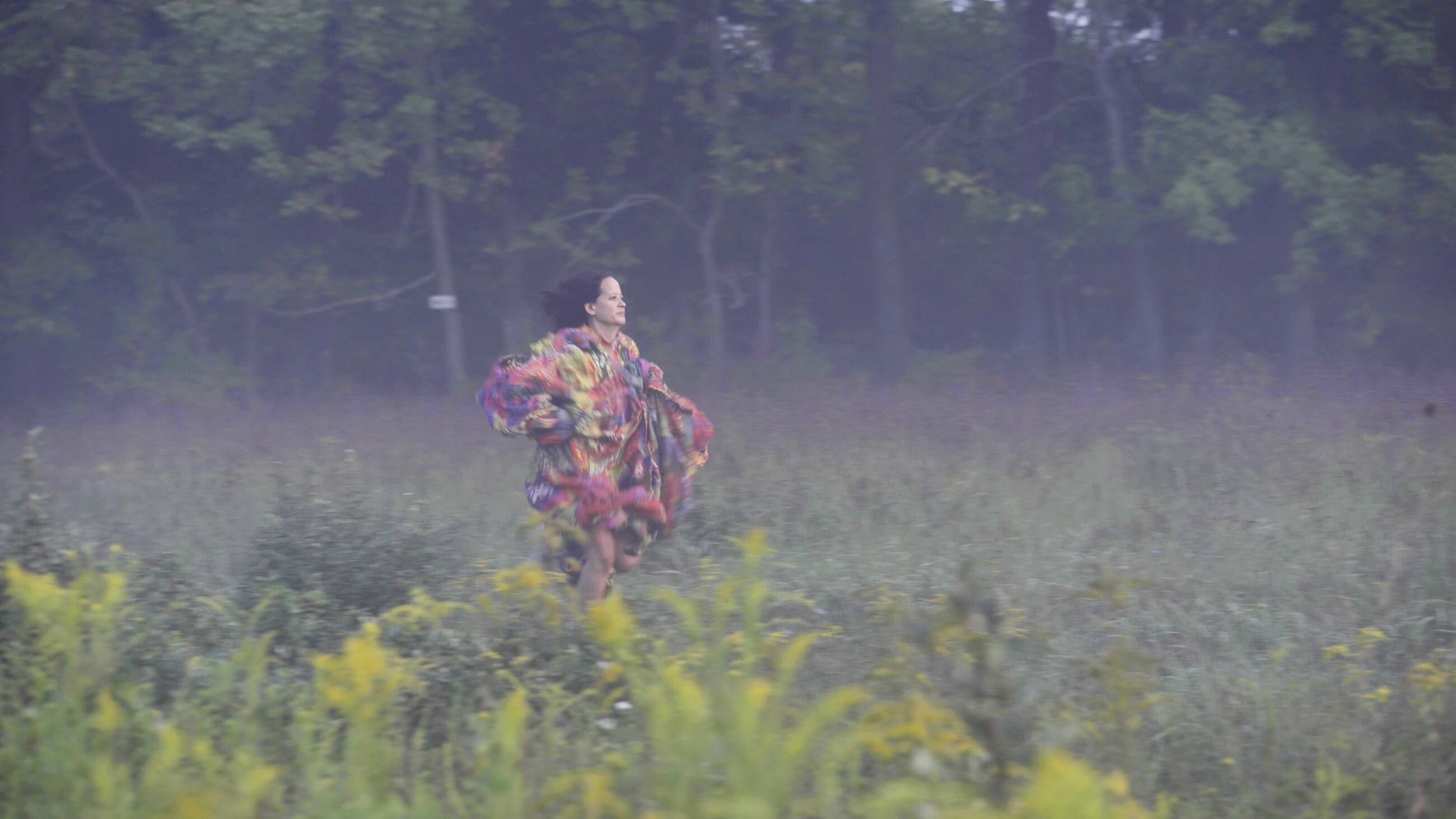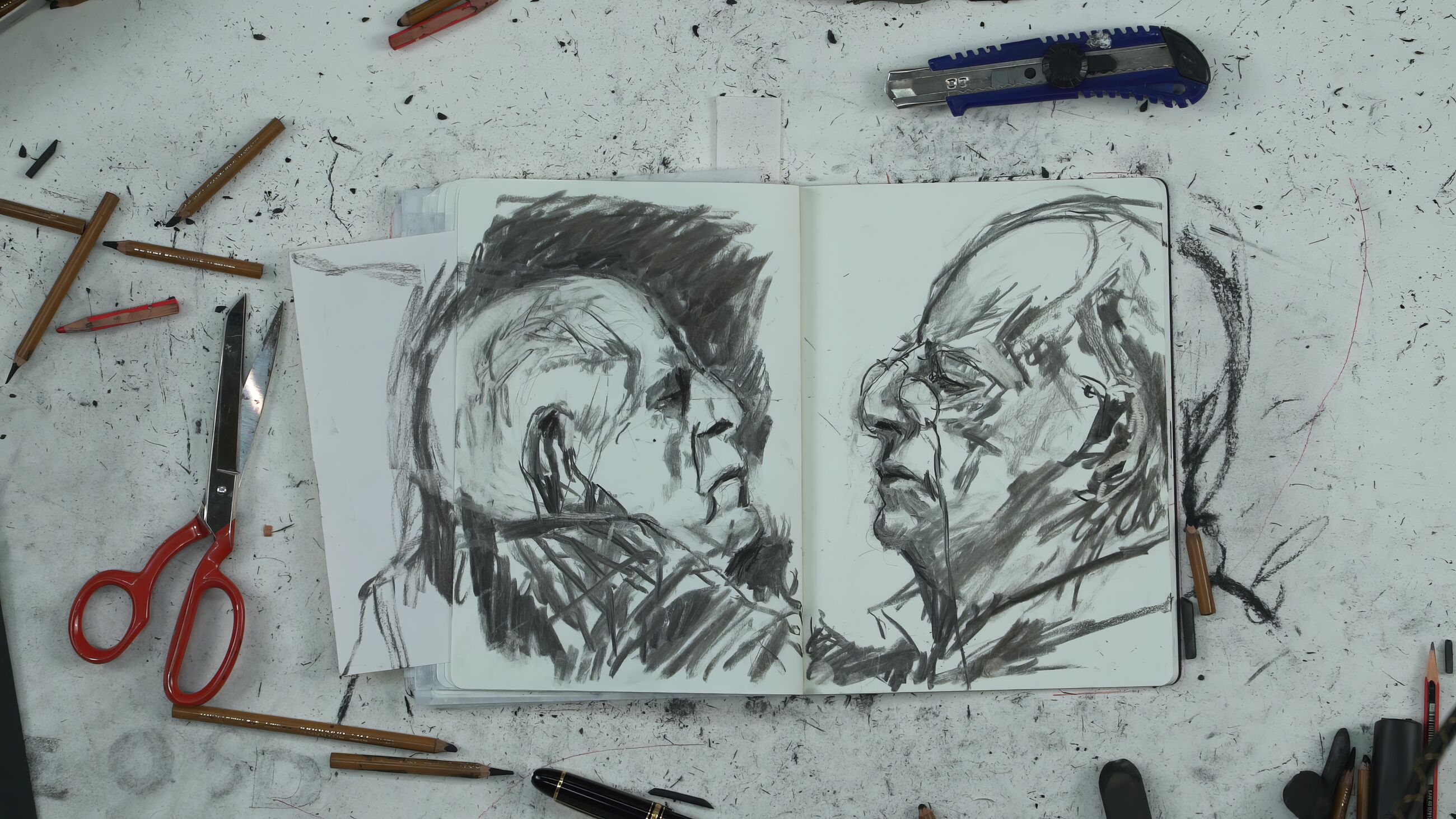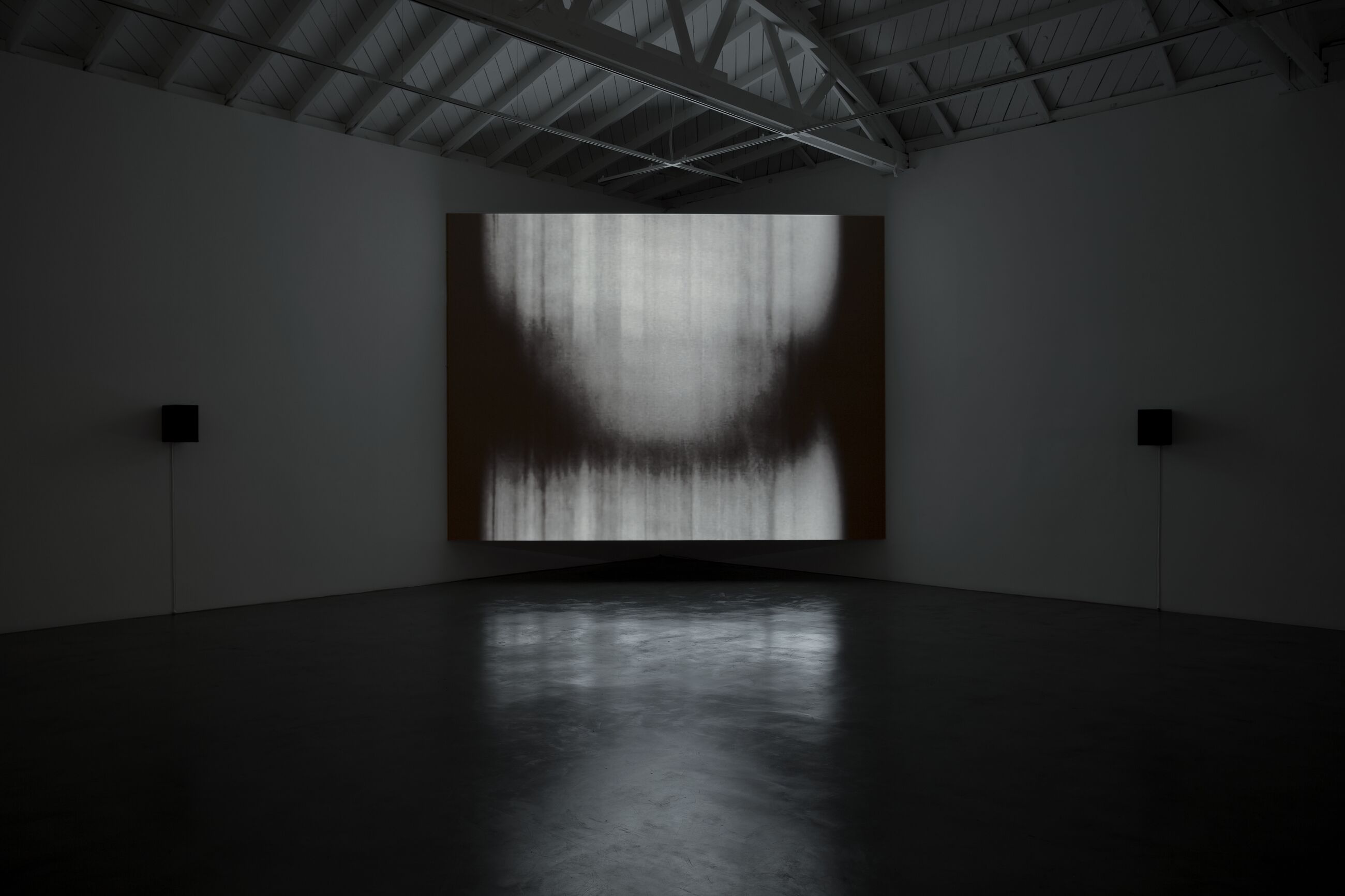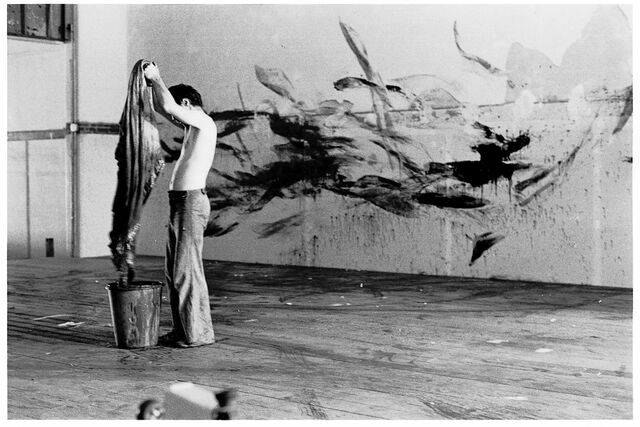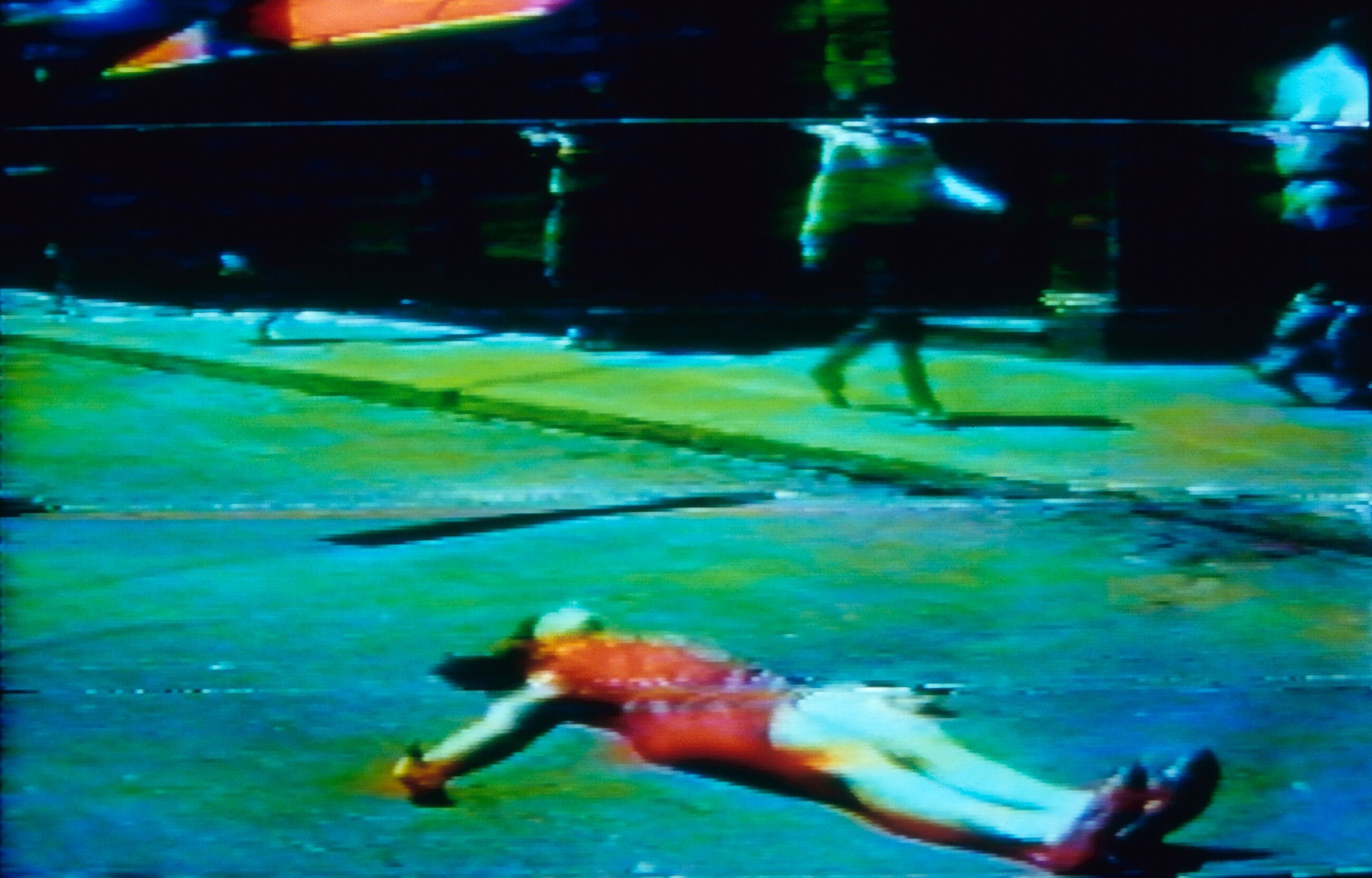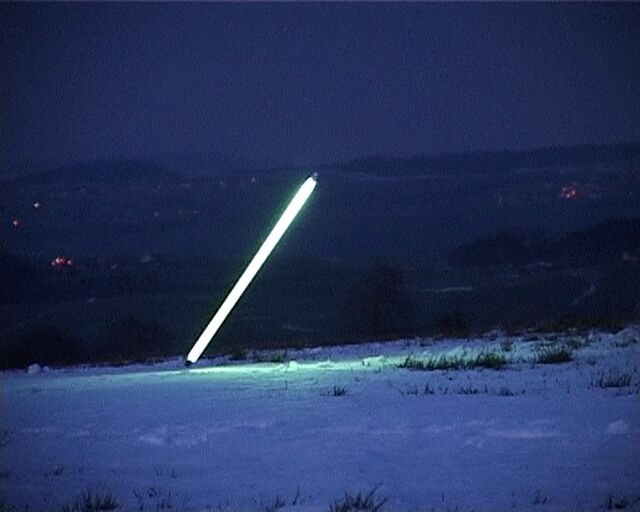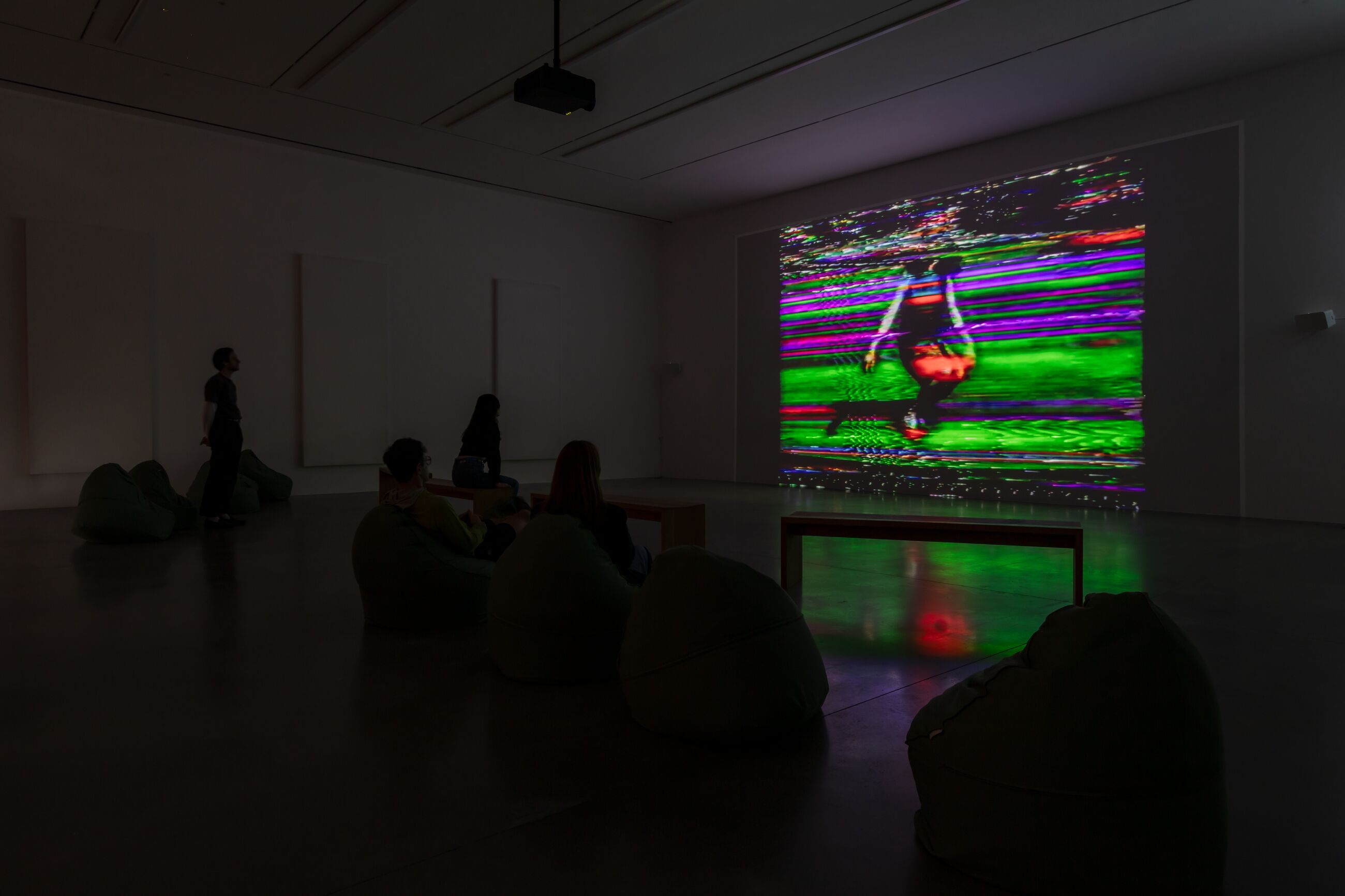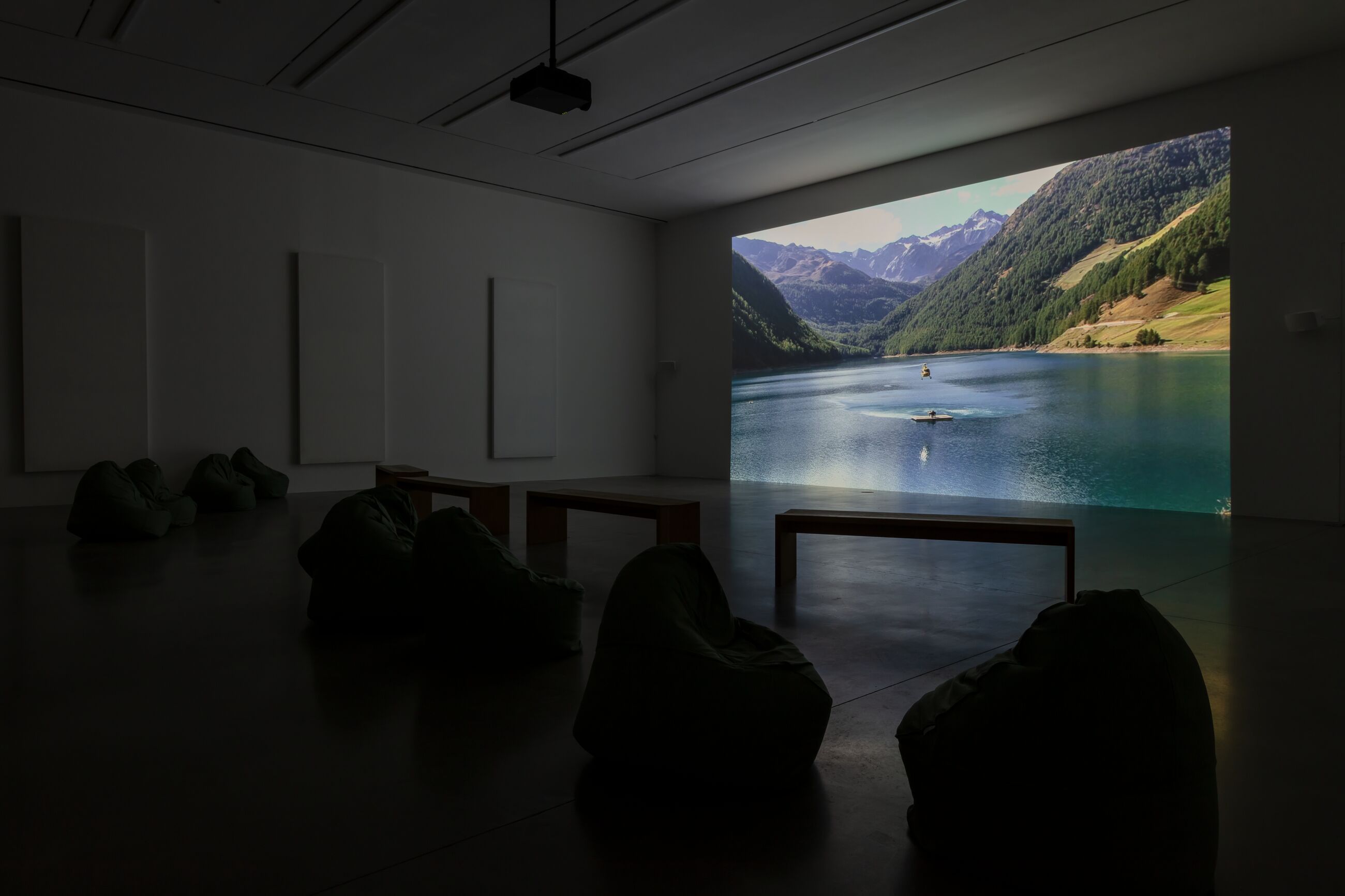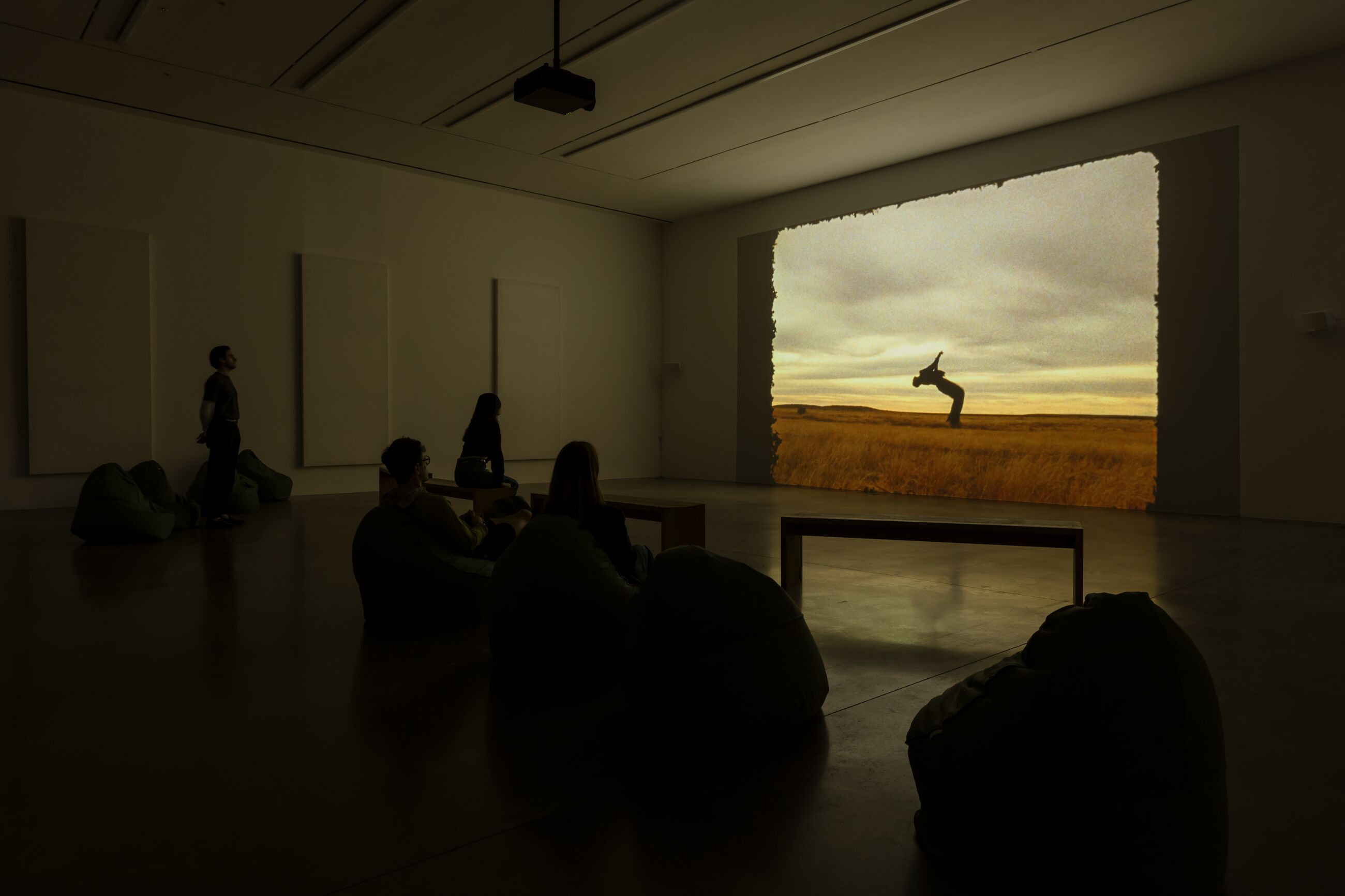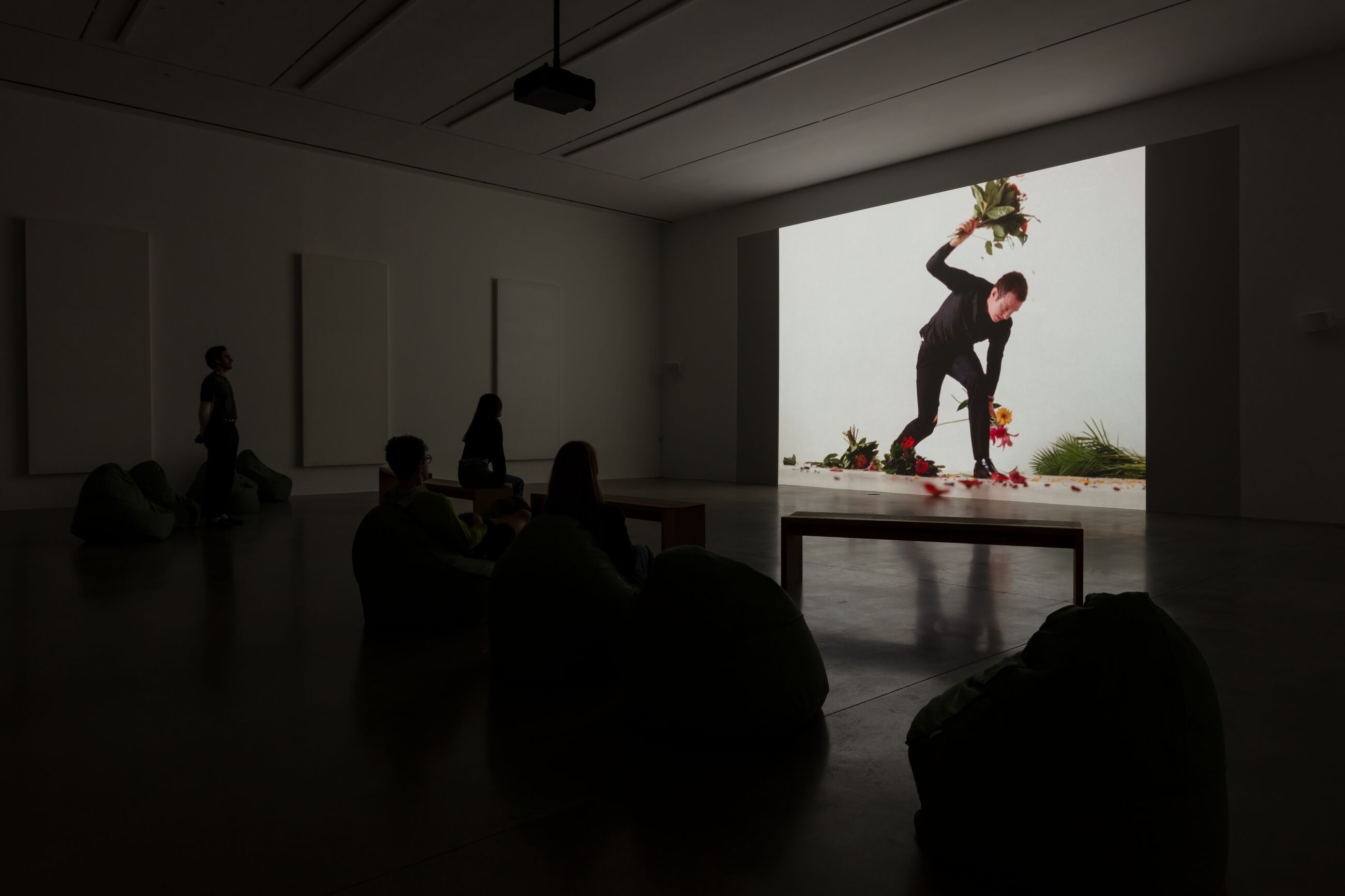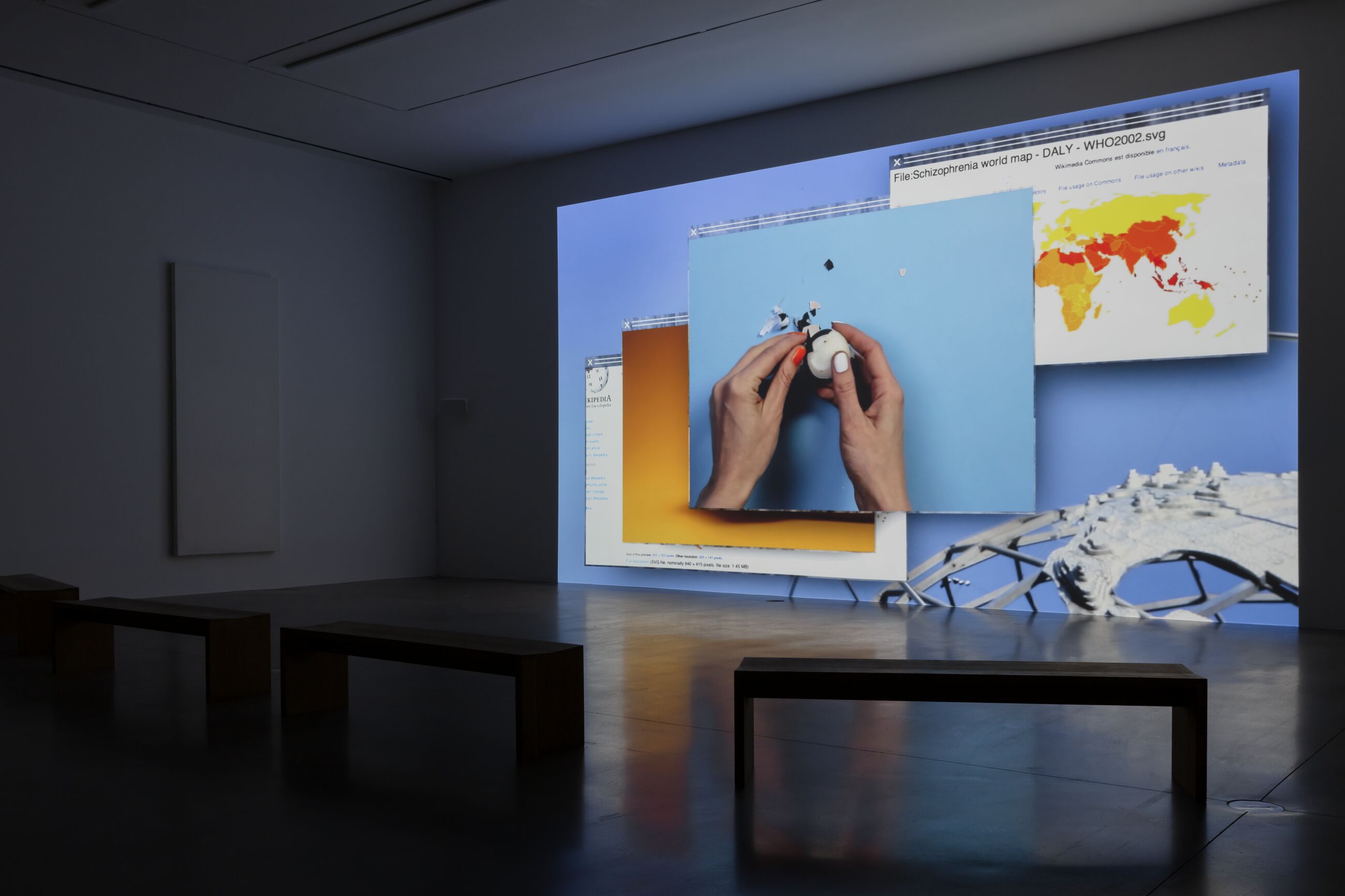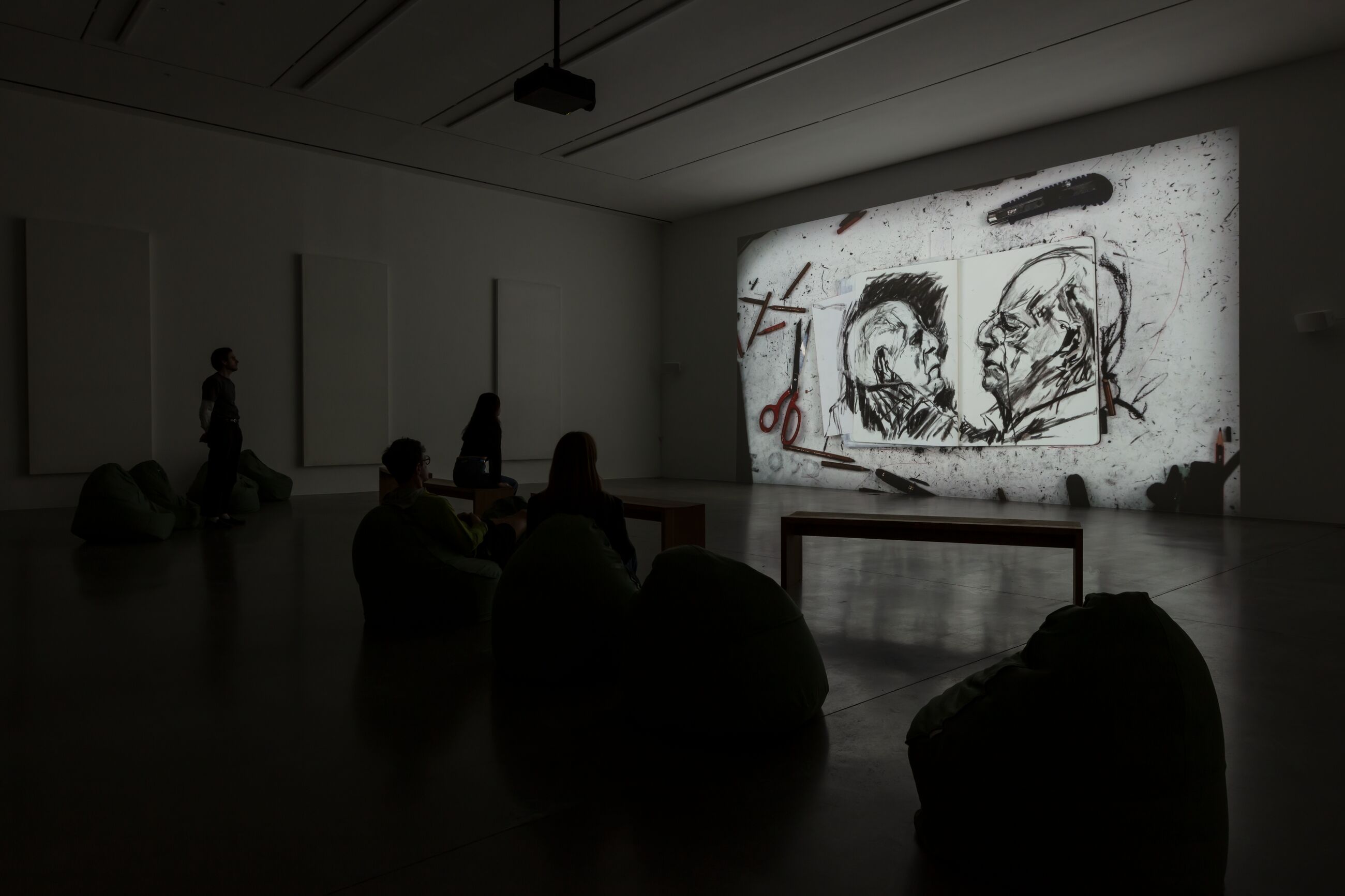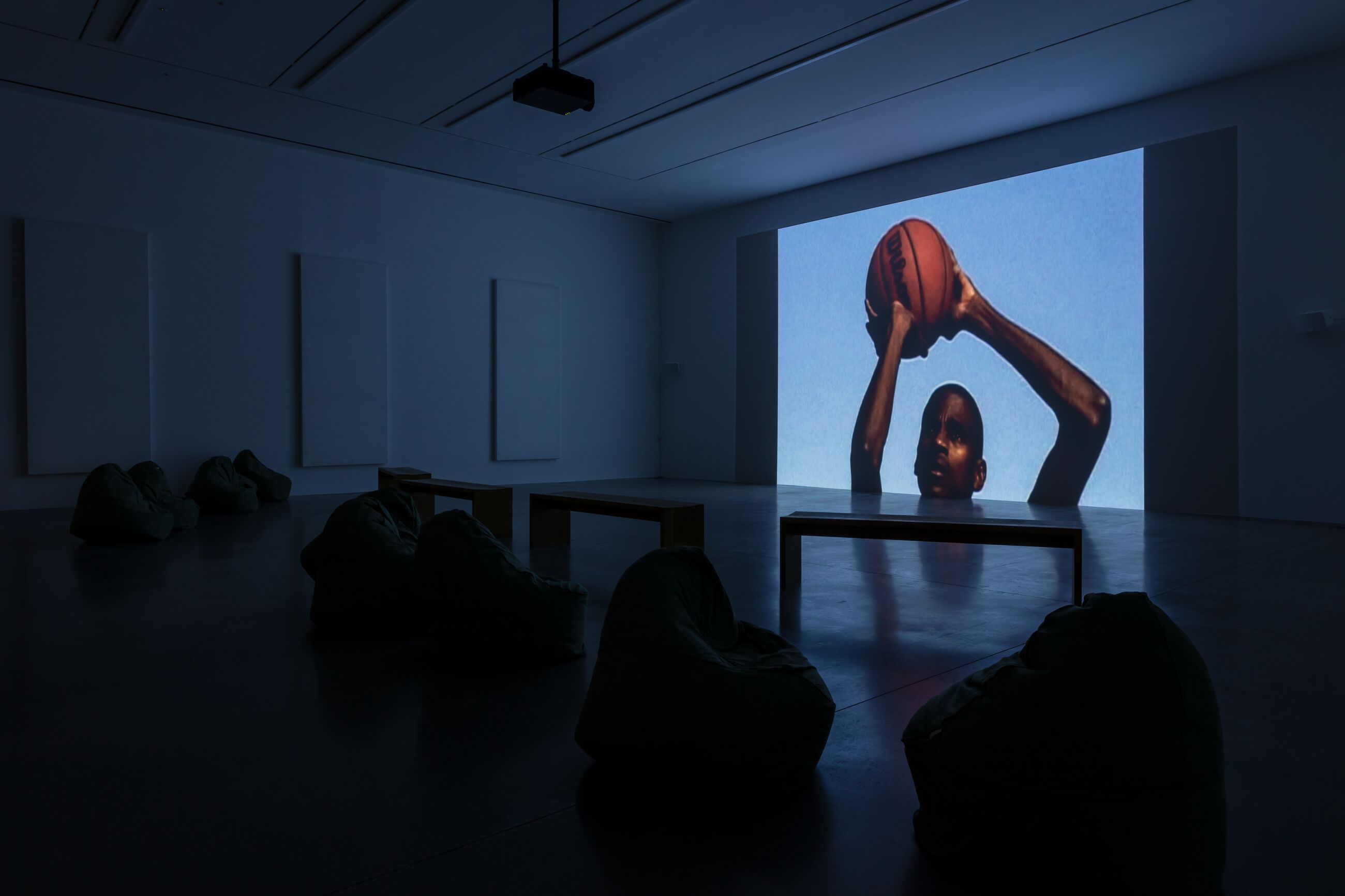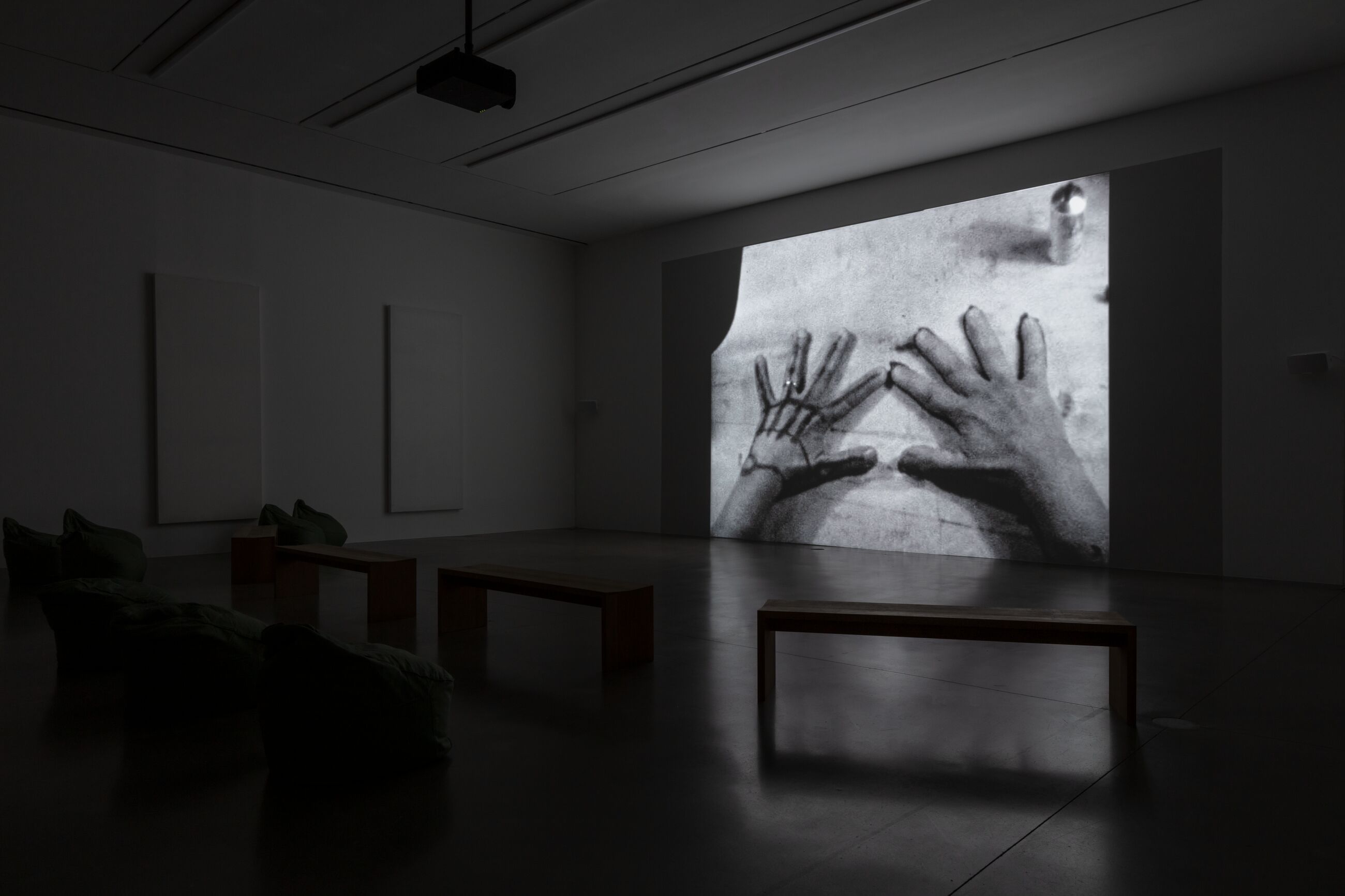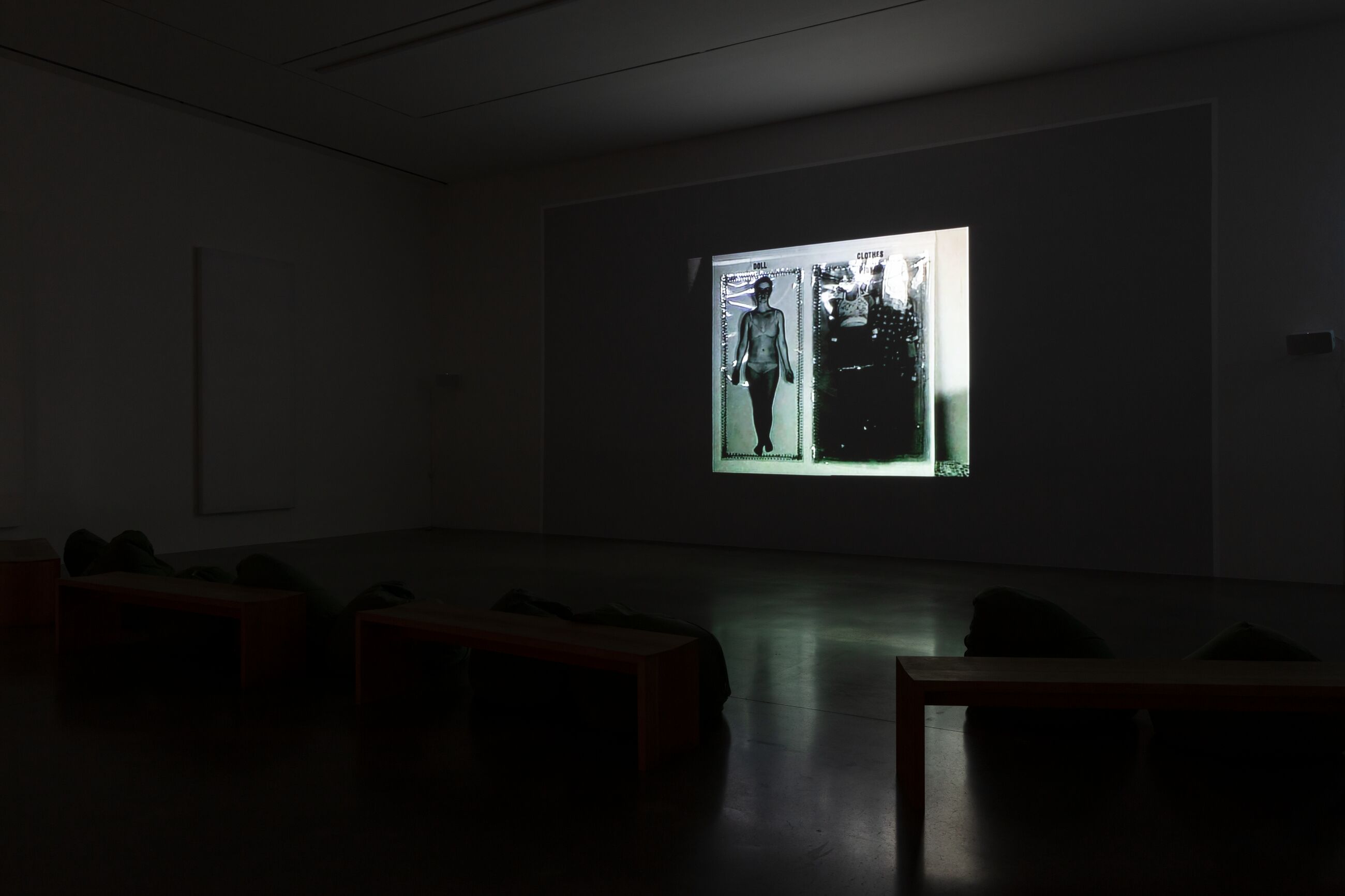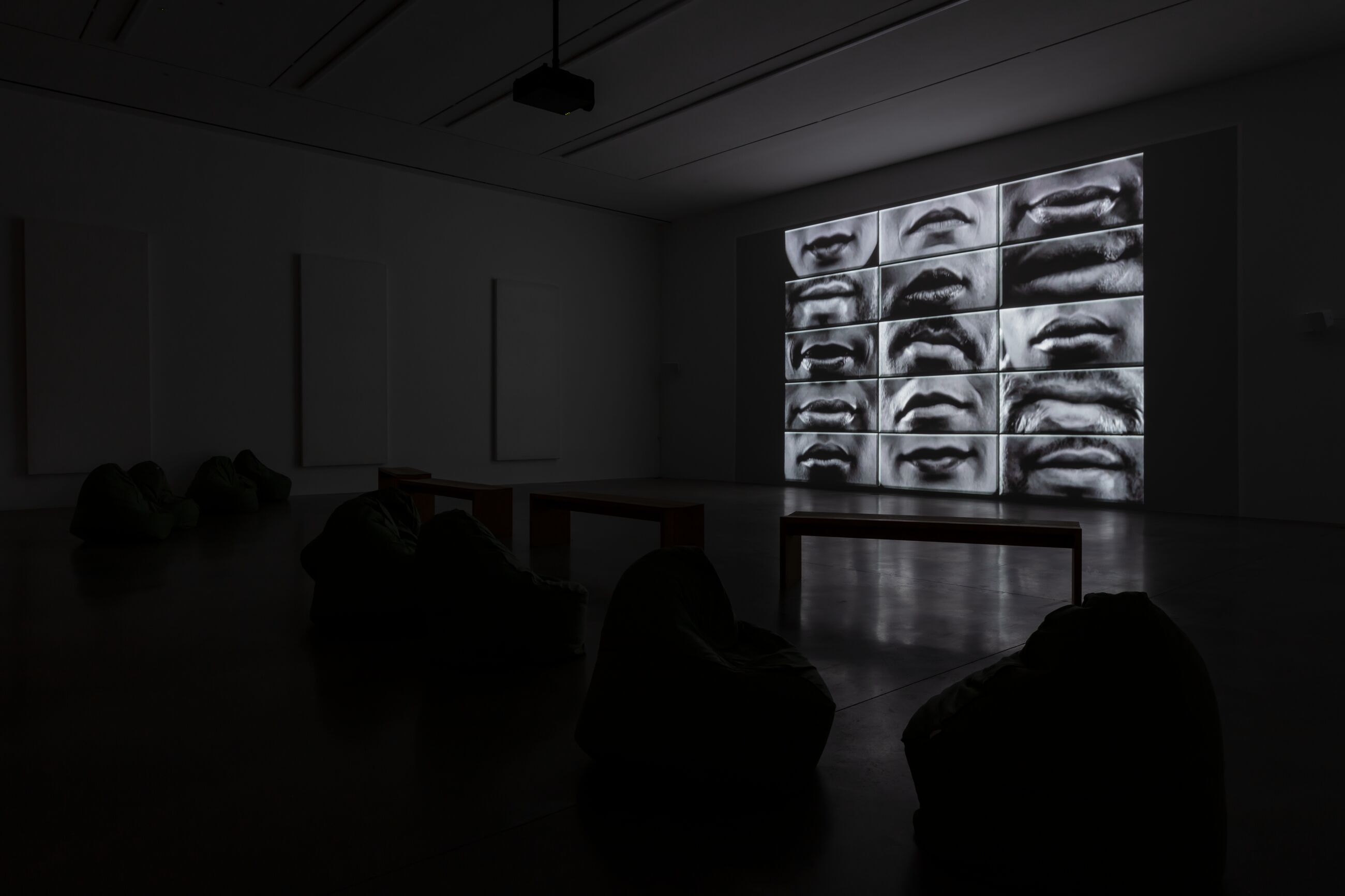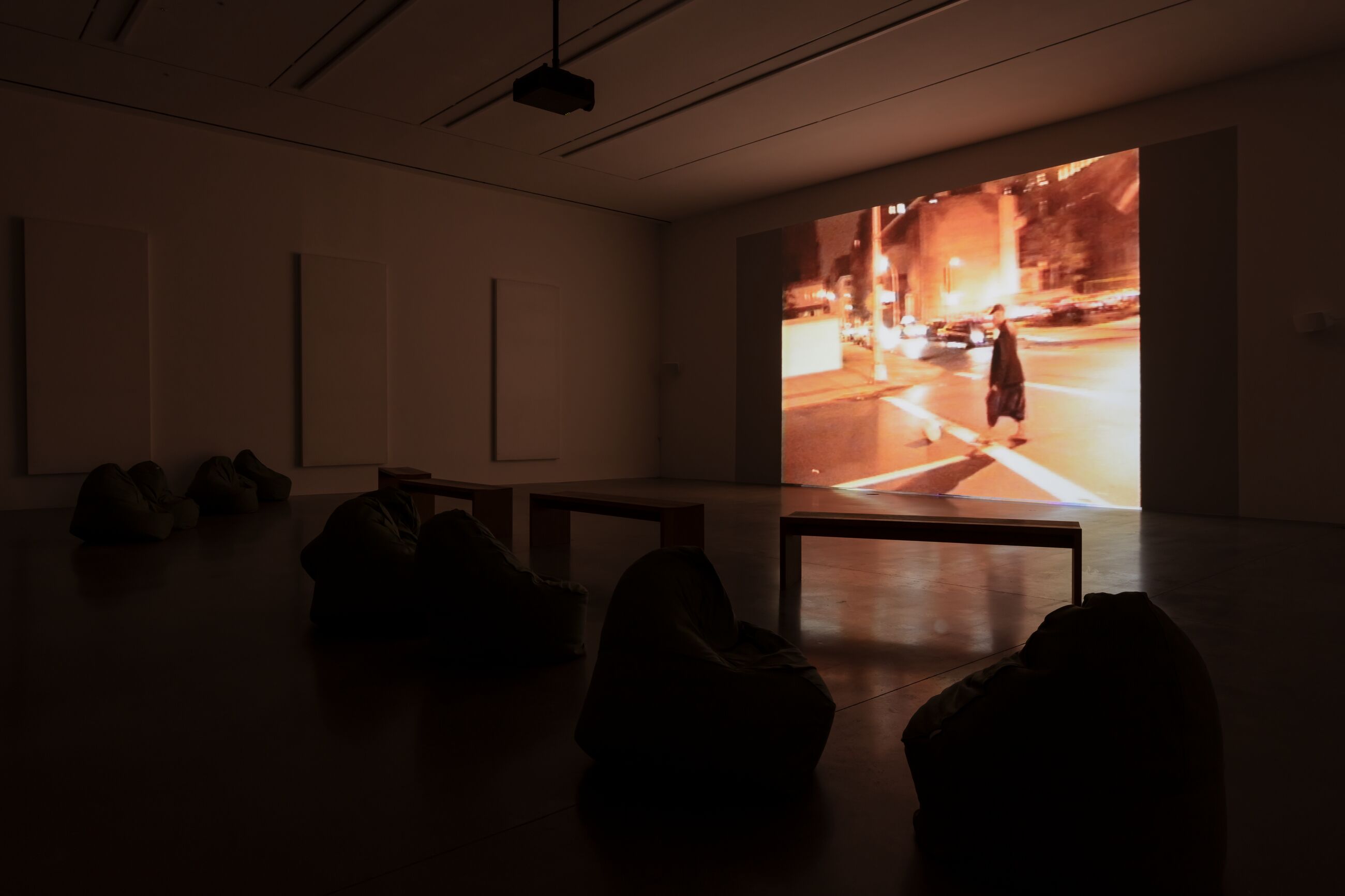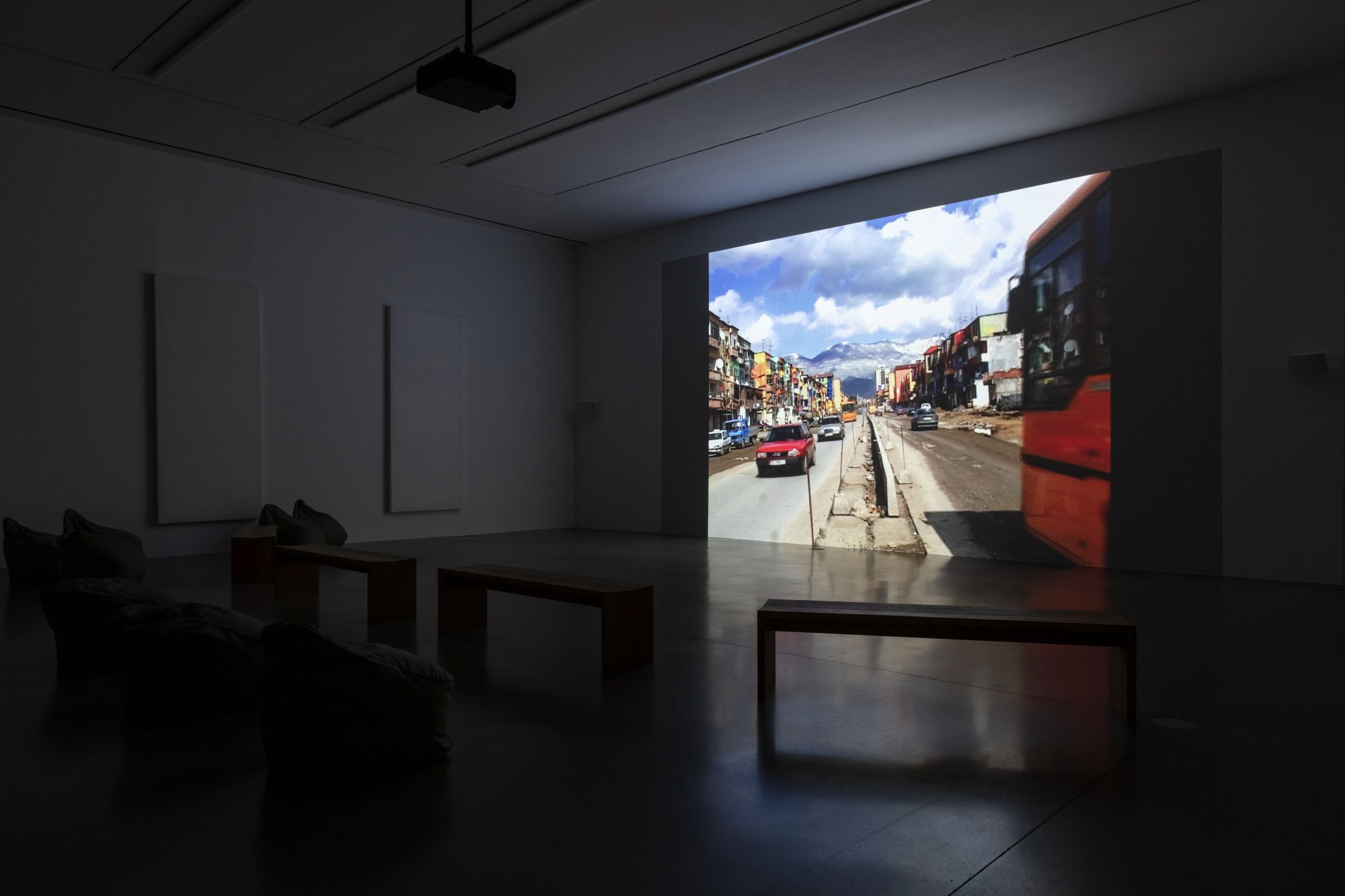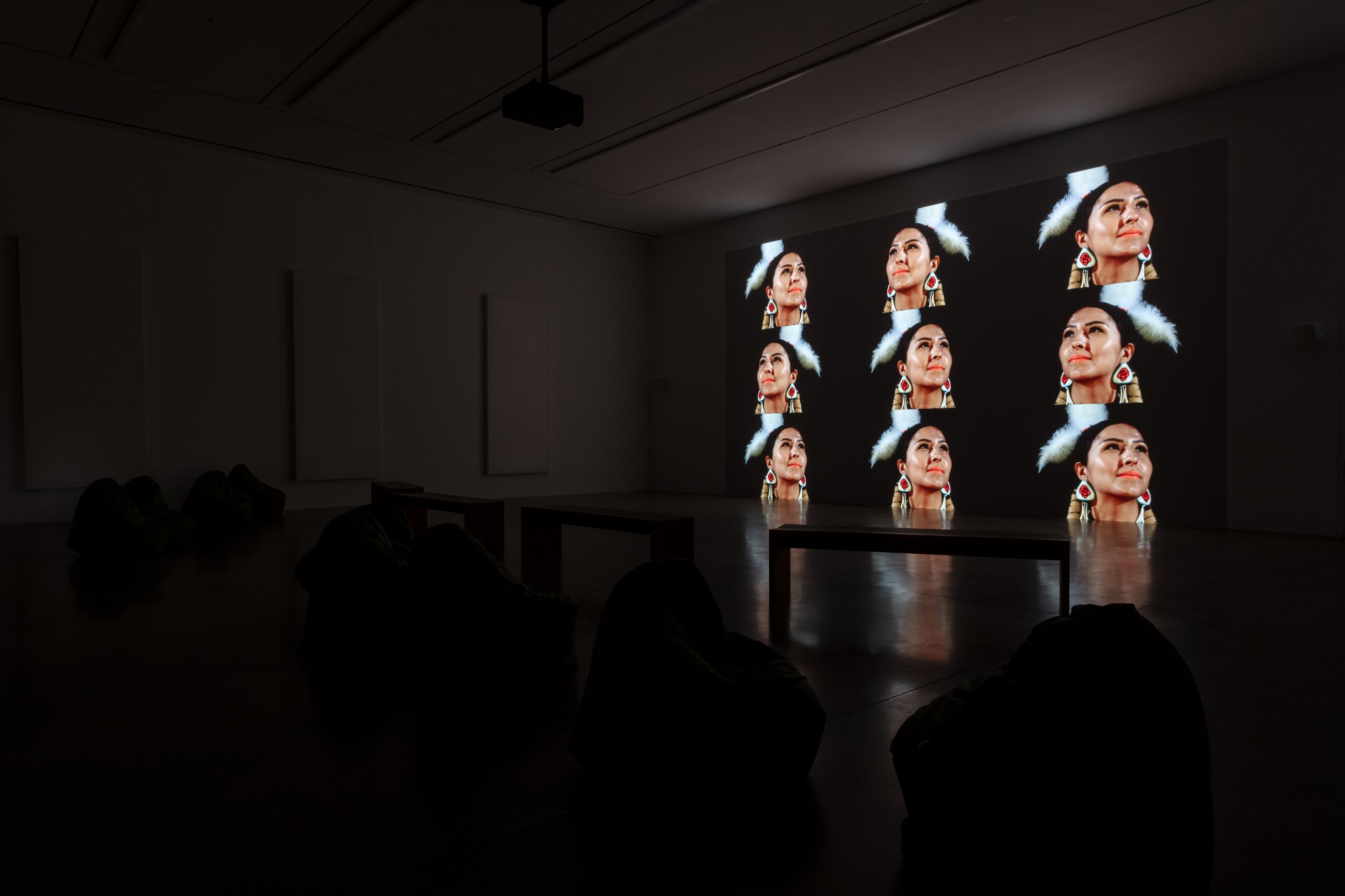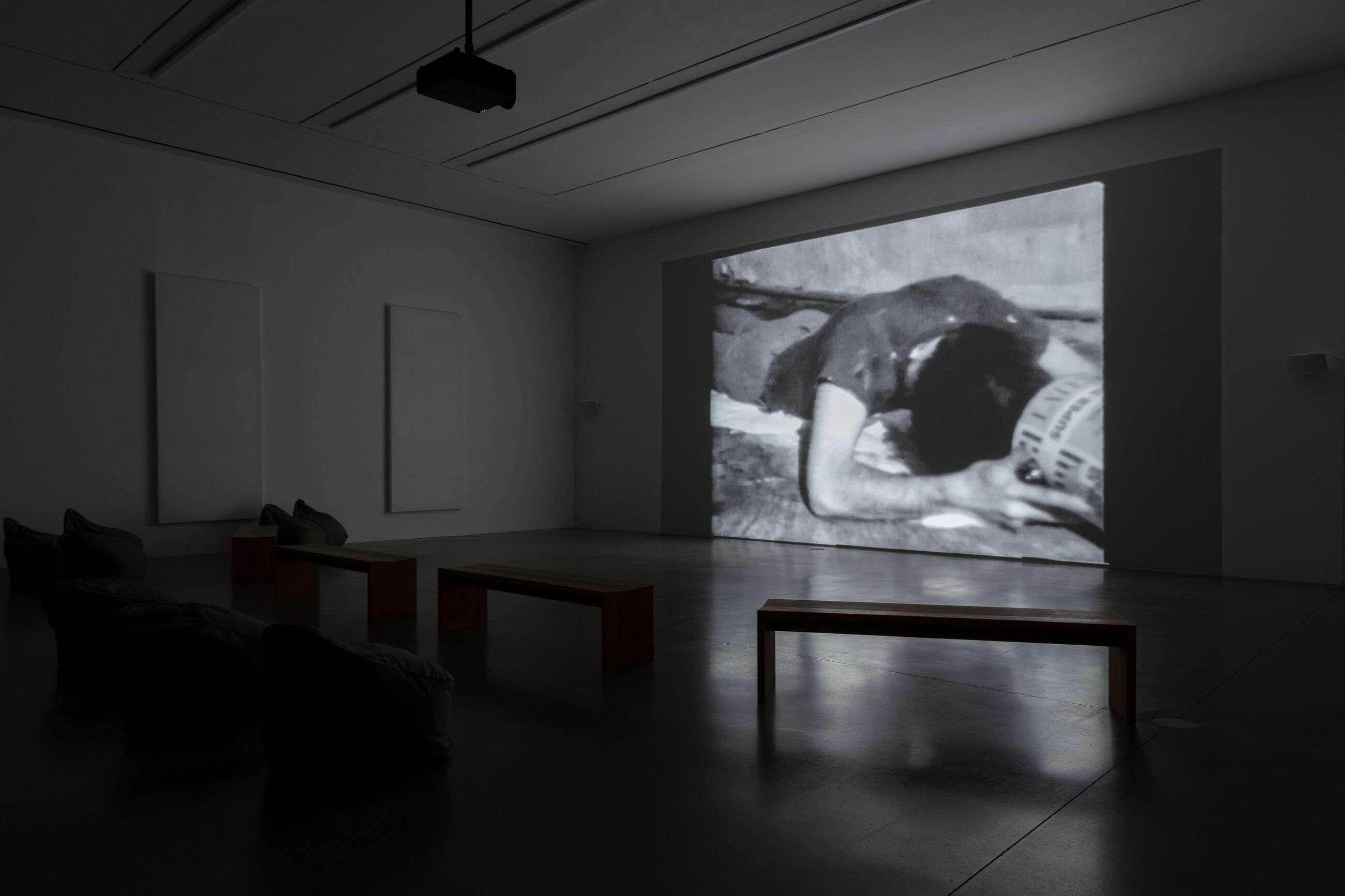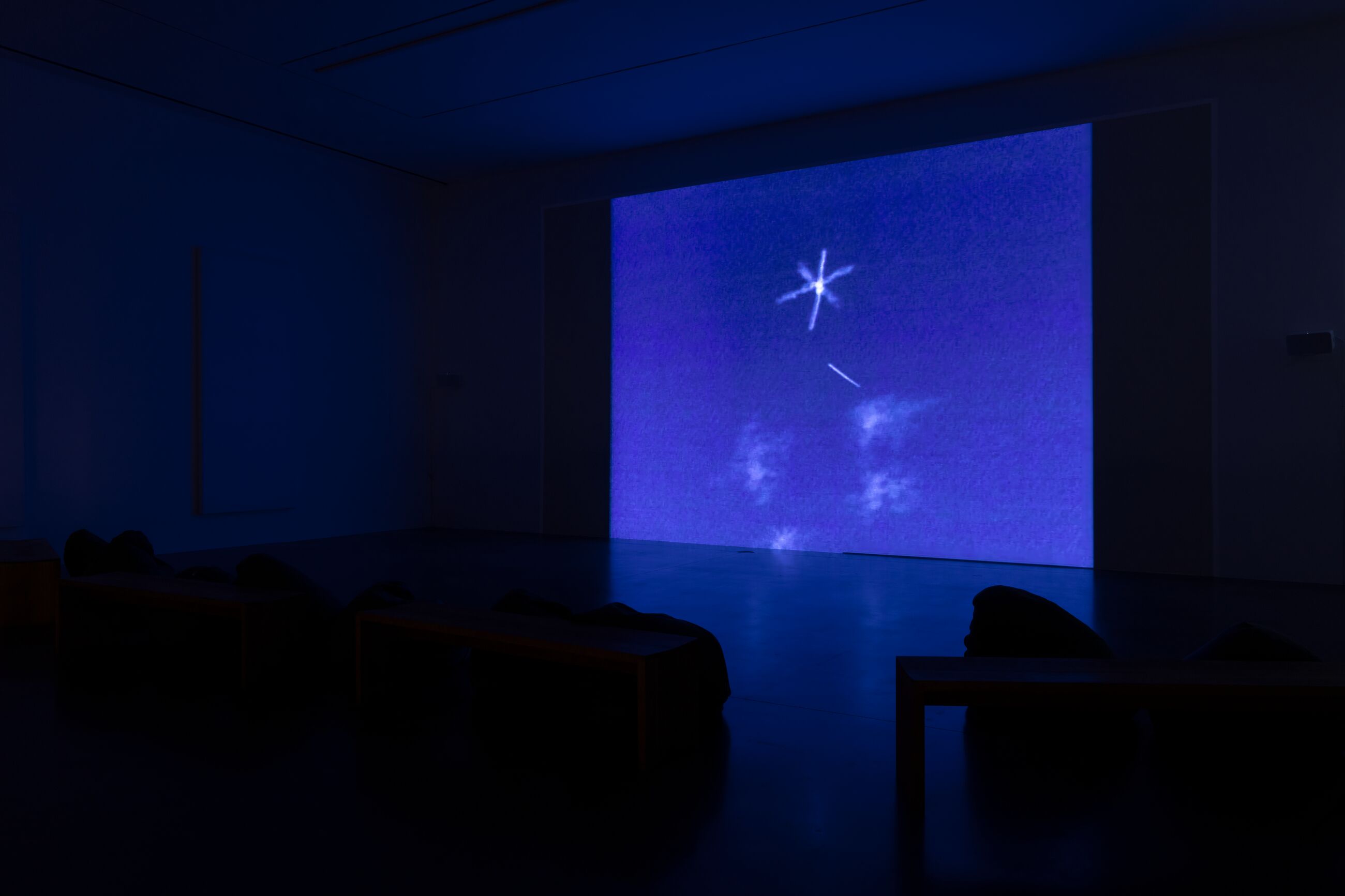
Figure + Ground
Selected Film and Video Works
6 June – 2 August 2025
London
Dates
6 June – 2 August 2025
This summer, Hauser & Wirth London presents ‘Figure + Ground,’ an exhibition of selected, single-screen film and video works made by 19 leading artists from the gallery’s roster. Opening during London Gallery Weekend, the North Gallery will be transformed into a screening room for the first time.
The exhibition brings together a variety of artists whose films and videos can be interpreted as exploring the dynamic between figure and ground in diverse ways. The selection of works also spotlights the development of moving image from the late 1960s to today. From film to the advent of analogue (single channel) video technologies during the early 1970s onwards, and later digital video, this technological expansion engendered a new genre of artistic production.
The artists featured are Sonia Boyce with Ain Bailey, Mark Bradford, Geta Brătescu, Martin Creed, Jeffrey Gibson, David Hammons, Camille Henrot, Rashid Johnson, William Kentridge, Glenn Ligon, Paul McCarthy, Pipilotti Rist, Mika Rottenberg, Anri Sala, Cindy Sherman, Roman Signer, Gary Simmons, Lorna Simpson and David Zink-Yi.
Installation Views
1 / 14
Related Content
About the Artists

Sonia Boyce
Over the course of four decades, Sonia Boyce DBE RA has developed a powerfully original practice that transcends boundaries as an interdisciplinary artist and academic working across film, photography, print, sound and installation. Boyce creates immersive and experiential spaces that explore themes of play, disruption and revelation in which the audience become active participants. Boyce’s practice today is focused on questions of artistic authorship and cultural difference. She continues to break new ground through her commitment to questioning the production and reception of unexpected gestures, with an underlying interest in the intersection of personal and political subjectivities. In 2022, Boyce presented ‘FEELING HER WAY’, commissioned for the British Pavilion at the 59th International Art Exhibition—La Biennale di Venezia for which she was awarded the Golden Lion for Best National Participation.
In 1980, Boyce completed a foundation course in art and design at East Ham College of Art and Technology, London, and in 1983, she received a BA in fine art from the former Stourbridge College in Stourbridge, England. During her time at Stourbridge College, Boyce attended the First National Black Art Convention at the nearby Wolverhampton Polytechnic. It was here that the artist would meet peers Lubaina Himid and Claudette Johnson, and become part of the British Black Arts Movement of the 1980s. Her large-scale pastel works from this brief period depicted domestic scenes from Afro-Caribbean life in the UK, drawing on Boyce’s personal experiences from her family and childhood. Foregrounding her own experience, works such as ‘Missionary Position II’ (1985) and ‘She Ain’t Holding Them Up, She’s Holding On (Some English Rose)’ (1986), explore questions of identity, race and cultural difference, themes, along with self-narration, that would continue to inform her career.
Boyce moved away from self-representation soon after and embraced an increasingly conceptual, social art practice. Utilising a range of media including photography, video and installation, her work developed into a collaborative mode of working, engaging with the audience in playful yet provocative situations. Despite this shift in method, issues of the body would remain central at this stage. In the early 90s, the artist began buying and collecting hair from Afro-Caribbean hair shops, which she turned into a series of 50 small, handheld sculptures from her Do You Want to Touch? series, objects that Boyce describes as ‘fragments of the African diasporic body’. Questions of the Black body as ‘other’ are also explored in the photographic installation work ‘The Audition’ (1997), in which Boyce invited members of the public to be photographed wearing a costume afro wig.
Since 1990, Boyce has been closely collaborating with other artists, frequently involving one- off improvisations and spontaneous performative actions made by the collaborators. Key works in subsequent decades include Boyce’s filmed improvisational performance ‘For you, only you’ (2007) that brought together a choir singing a piece of 15th-century sacred music and the artist Mikhail Karikis, who communicates with the choir in a series of non-verbal stutters and guttural vocalisations. In later works such as ‘We Move in Her Way’ (2017), the artist combines improvisational sound and movement performances from Elaine Mitchener and Barbara Gamper. Boyce documents these improvised encounters without intervening, and later constructs them into immersive multi-media installations.
For her latest installation work, ‘Feeling Her Way’ (2022), part of her presentation for the British Pavilion at the 2022 Venice Biennale, Boyce recorded five intergenerational Black female musicians interacting, improvising and playing with their voices, exploring the notion of what it means to be free. As Boyce says of her interest in exploring social dynamics, ‘I’m more interested in human responses than anything else…how to learn, how to listen, how to watch things and be in it; not be separate from it, not to have a kind of arm’s length relation to what might be unfolding with other people.’ The work expands on Boyce’s ‘Devotional Collection’, an ongoing archive project begun in 1999 which celebrates and brings into focus Black British female musicians, many of whom have been underacknowledged. The project has featured in exhibitions including a retrospective of Boyce’s work at Manchester Art Gallery in 2018.
For nearly forty years, Boyce has consistently worked within the art school context where she has made invaluable contributions to reshape the discourse of art through her work as an academic. Since 2014 she has been a Professor at University of the Arts London, where she holds the inaugural Chair in Black Art & Design. A three-year research project into Black Artists and Modernism culminated with the 2018 BBC Four documentary ‘Whoever Heard of a Black Artist?’, exploring the contribution of overlooked artists of African and Asian descent to the story of Modern British art. She holds three honorary doctorates from the Royal College of Art (2019), the Courtauld Institute of Art and Birmingham City University (2023), and an honorary fellowship from Norwich University of Arts (2022).
Boyce’s work is held in the collections of Tate, London, UK; Victoria & Albert Museum, London, UK; Arts Council Collection, London, UK; The Government Art Collection, London, UK; British Council Collection, London, UK and Pallant House Gallery, Chichester, UK.
Boyce has been the recipient of numerous awards. In 2024, the artist received an DBE for services to art in the Queen’s New Year Honours List. In 2016, Boyce was elected a Royal Academician, and received a Paul Hamlyn Artist Award. Between 2012 and 2017, Boyce was Professor of Fine Art at Middlesex University and since 2014 she has been Professor at the University of the Arts London. As the inaugural Chair of Black Art & Design she led on a three-year research project into Black Artists & Modernism, which led to a BBC documentary Whoever Heard of a Black Artist? Britain’s Hidden Art History (2018).
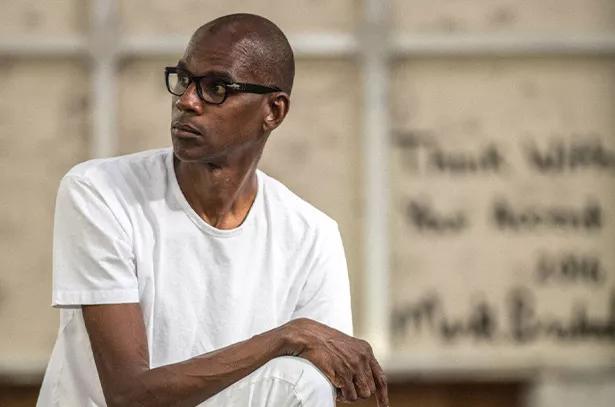
Mark Bradford
Mark Bradford (b. 1961 in Los Angeles; lives and works in Los Angeles) is a contemporary artist best known for his large-scale abstract paintings created out of paper. Characterized by its layered formal, material, and conceptual complexity, Bradford’s work explores social and political structures that objectify marginalized communities and the bodies of vulnerable populations. Just as essential to Bradford’s work is a social engagement practice through which he reframes objectifying societal structures by bringing contemporary art and ideas into communities with limited access to museums and cultural institutions.
Using everyday materials and tools from the aisles of the hardware store, Bradford has created a unique artistic language. Referred to frequently as ‘social abstraction,’ Bradford’s work is rooted in his understanding that all materials and techniques are embedded with meaning that precedes their artistic utility. His signature style developed out of his early experimentation with end papers, the small, translucent tissue papers used in hairdressing; he has since experimented with other types of paper, including maps, billboards, movie posters, comic books, and ‘merchant posters’ that advertise predatory services in economically distressed neighborhoods.
After gluing an image pre-selected for its historical significance onto canvas, Bradford outlines it with rope or caulk before affixing numerous layers of different types of paper. The artist then lacerates, erodes, and excavates the surfaces of his paintings using ‘tools of civilization’ to reveal intersections between the layers of signifying materials, thereby transforming and expanding the medium of painting.
Born in South Los Angeles, Bradford moved to LA’s beachside Santa Monica neighborhood with his mother at age 11. Throughout his childhood he worked in his mother’s beauty salon in Leimert Park where he first developed a curiosity in artistic and creative expression, and after high school, Bradford spent his summers traveling in Europe. His experiences visiting museums and consuming art left an enduring impression, and for the first time, at the age of 31, he began his formal arts education.
Bradford received his BFA from the California Institute of the Arts (CalArts) in Valencia in 1995 and his MFA from CalArts in 1997. Bradford received his first solo exhibition, ‘Floss,’ at the San Francisco Art Institute’s Walter & McBean Galleries in 1998 and his New York museum debut in ‘Freestyle’ at the Studio Museum in Harlem in 2001. In 2006, Bradford participated in the Whitney Biennial at the Whitney Museum of American Art where he won the coveted Bucksbaum Award, leading to his first major solo museum exhibition the following year at the Whitney, ‘Neither New nor Correct.’ In 2008, in the wake of Hurricane Katrina, Bradford participated in Prospect.1 in New Orleans, and in 2010, the Wexner Center for the Arts presented a retrospective of his work that traveled for two years to five institutions around the US.
In 2015, Bradford received his first solo museum exhibition in Los Angeles, ‘Scorched Earth’ at the Hammer Museum, and that same year co-founded Art + Practice in Leimert Park with his longtime partner, Allan DiCastro, and philanthropist and art collector Eileen Harris Norton.
In 2017, Bradford represented the United States at the 57th Venice Biennale with his solo exhibition ‘Tomorrow is Another Day.’ Complementing the presentation at the US Pavilion and in keeping with his practice to engage marginalized communities, Bradford launched Process Collettivo, a six-year partnership with the Rio Terà dei Pensieri social cooperative that provides skills training and employment opportunities to incarcerated men and women in and around Venice. Following the Biennale, ‘Tomorrow is Another Day’ traveled to the Baltimore Museum of Art, where Bradford collaborated with Greenmount West Community Center (GWCC), a community art space offering educational resources to families in Baltimore.
In November 2017, Bradford unveiled ‘Pickett’s Charge’ at the Hirshhorn Museum and Sculpture Garden in Washington, DC, and in 2018, installed a 32-canvas painting of the text of the US Constitution titled ‘We The People’ for permanent display at the US Embassy in London. In 2019, Bradford produced ‘Life Size,’ a large image of a police body camera on a vinyl banner at the entrance to the backlot at the inaugural Frieze LA fair and on wheatpaste posters throughout Los Angeles. Bradford also created a limited-edition print series with the same image to raise money for the Art for Justice Fund to support career development opportunities for people transitioning out of prison.
Bradford has exhibited to acclaim internationally and received numerous awards and honors, including his appointment to the American Academy of Arts and Sciences in 2019, the US Department of State’s Medal of Arts in 2014, his appointment as a National Academician in 2013, and a MacArthur Fellowship Award in 2009. Permanent installations of Bradford’s work include ‘What Hath God Wrought’ (2018) on the campus of the University of California, San Diego, and ‘Bell Tower’ (2015) at the Tom Bradley International Terminal Departures Hall at Los Angeles International Airport.
Recent solo exhibitions of Bradford’s work include ‘Masses and Movements’ at Hauser & Wirth Menorca (2021), ‘End Papers’ (2020) at the Modern Art Museum of Fort Worth; ‘Cerberus’ (2019) at Hauser & Wirth London; and ‘Los Angeles’ (2019) at the Long Museum West Bund, Shanghai.
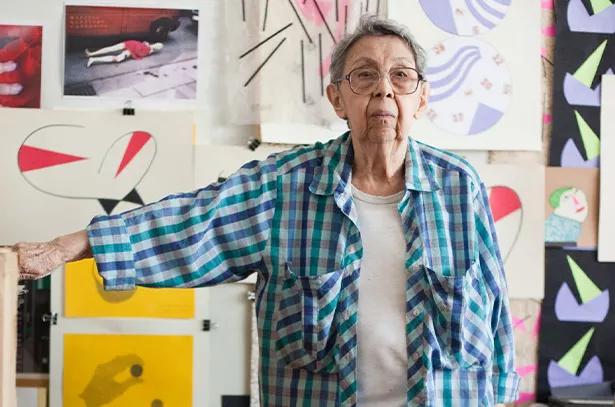
Geta Brătescu
One of the first representatives of conceptualist approaches in Romania, Geta Brătescu’s oeuvre comprises drawing, collage, textiles, photography, experimental film and performance. In her seven-decade career, she has published a number of books documenting her daily studio activities and personal experiences of art and travel.
Brătescu spent much of her working life in Bucharest under the Communist regime. She developed a deeply personal practice concerned with themes of identity, gender and dematerialisation. Her aesthetic—lo-fi, handmade, incorporating inexpensive, everyday materials—evolved from an attitude towards her studio as a safe environment of enclosure as well as a stage for playful invention. Memorialised in a key film, ‘The Studio,’ 1978 was a room of her own in which she could create work independently.
In addition to the objects and materials at hand, Brătescu was devoted to literature and would often draw inspiration from the stories of characters in famous texts. Aesop and Medea, Mother Courage and Faust, all played starring roles in her work, functioning as alter-egos and conduits for self-expression and frequently an oblique form of political subversion.
From 1945 to 1949, she studied at the Faculty of Letters and Philosophy at the University of Bucharest and at the Bucharest Academy of Fine Arts. In 1950 her studies were interrupted by the Communist government, and she was unable to complete her art education until 1971. Following her exclusion from university, Brătescu maintained a studio practice whilst working as an illustrator and graphic designer, becoming in the early 1960s the artistic director of the prestigious literary magazine, Secolul 20.
In 2008 Brătescu was honored with the title of Doctor Honoris Causa from the National Arts University in Bucharest for her contribution to the landscape of contemporary Romanian art. In 2017 she represented Romania at the Venice Biennale and was awarded by the President of Romania the Order of the Star of Romania.
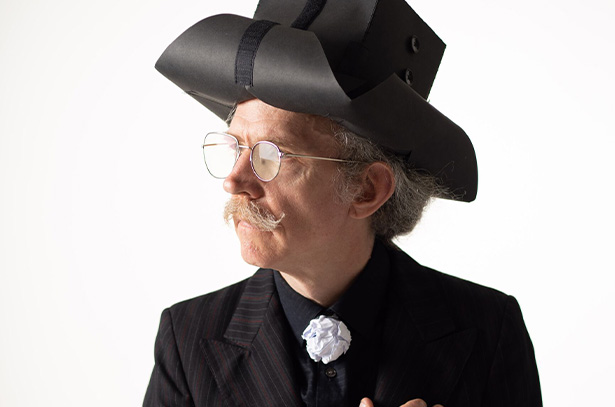
Martin Creed
‘Creed is a social artist; the true magic of his work lies in the way it interacts with people and places.’
—Jonathan Jones, ‘Martin Creed’s stairway to heaven,’ in The Guardian, London, UK, 1 August 2011, ill. (on Work No. 1059)
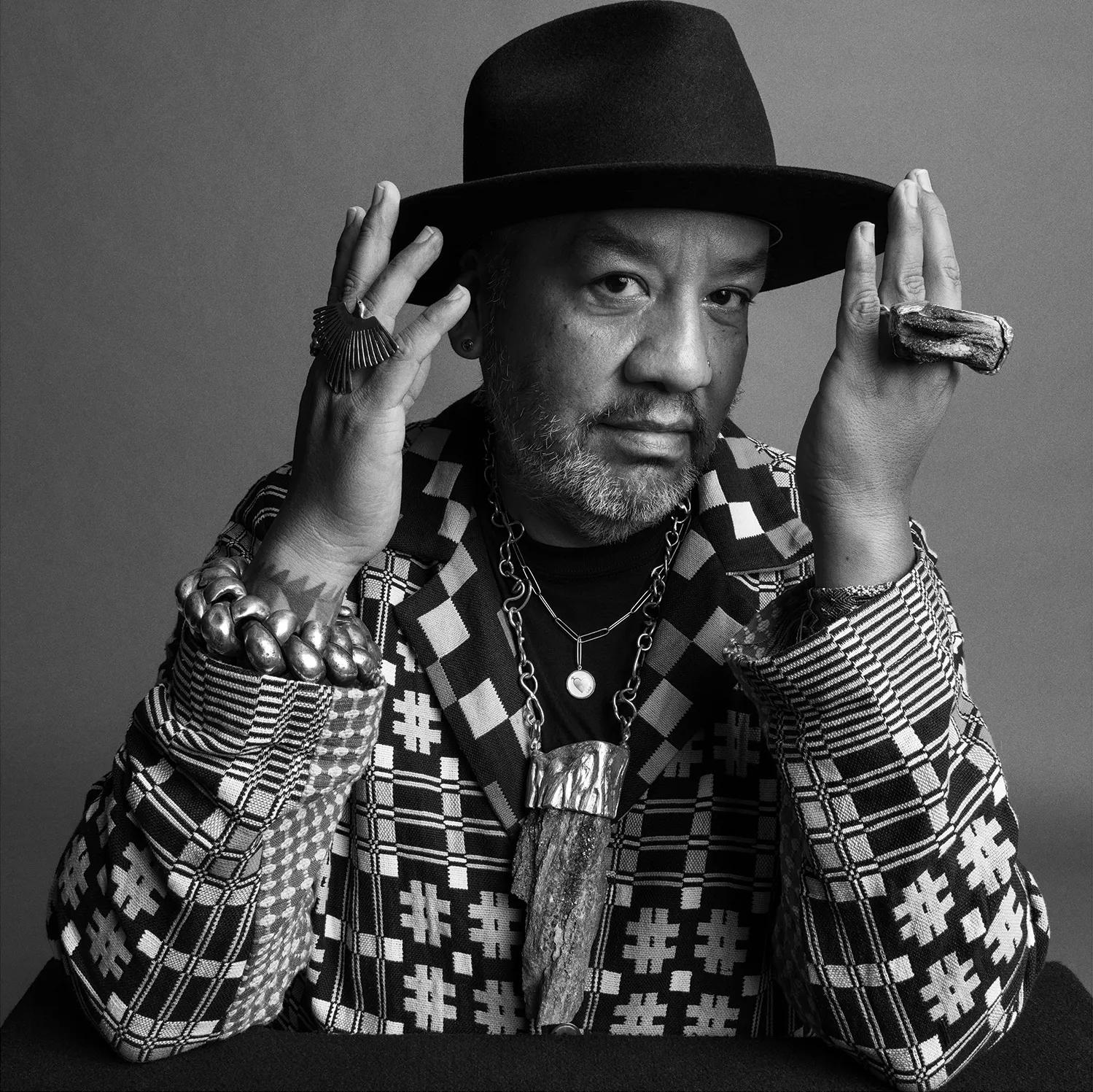
Jeffrey Gibson
Jeffrey Gibson grew up in major urban centers in the United States, Germany, and Korea, where he absorbed the transgressive soundtrack of the 1980s through limited access to MTV. Gibson graduated from the School of the Art Institute of Chicago in 1995 and received a Master of Arts in painting at the Royal College of Art, London, in 1998. While in Chicago he also worked as a research assistant on the Native American Graves Protection and Repatriation Act (NAGPRA) for the Field Museum, a formative experience that fostered an ongoing interest in questions of ownership and notions of cultural translation. Though trained as a painter, Gibson began incorporating materials and techniques that deliberately reference his heritage—such as raw hides and bead work—around 2010. A major turning point in his career, in 2012 he presented ‘one becomes the other,’ his first solo exhibition of sculpture and video, at Participant Inc. Sculpture, moving image, and sound have since become an integral aspect of his practice. He is known for his immersive, multi-sensory installations that invoke and interweave such disparate contexts as faith-based spaces of communion and night clubs.
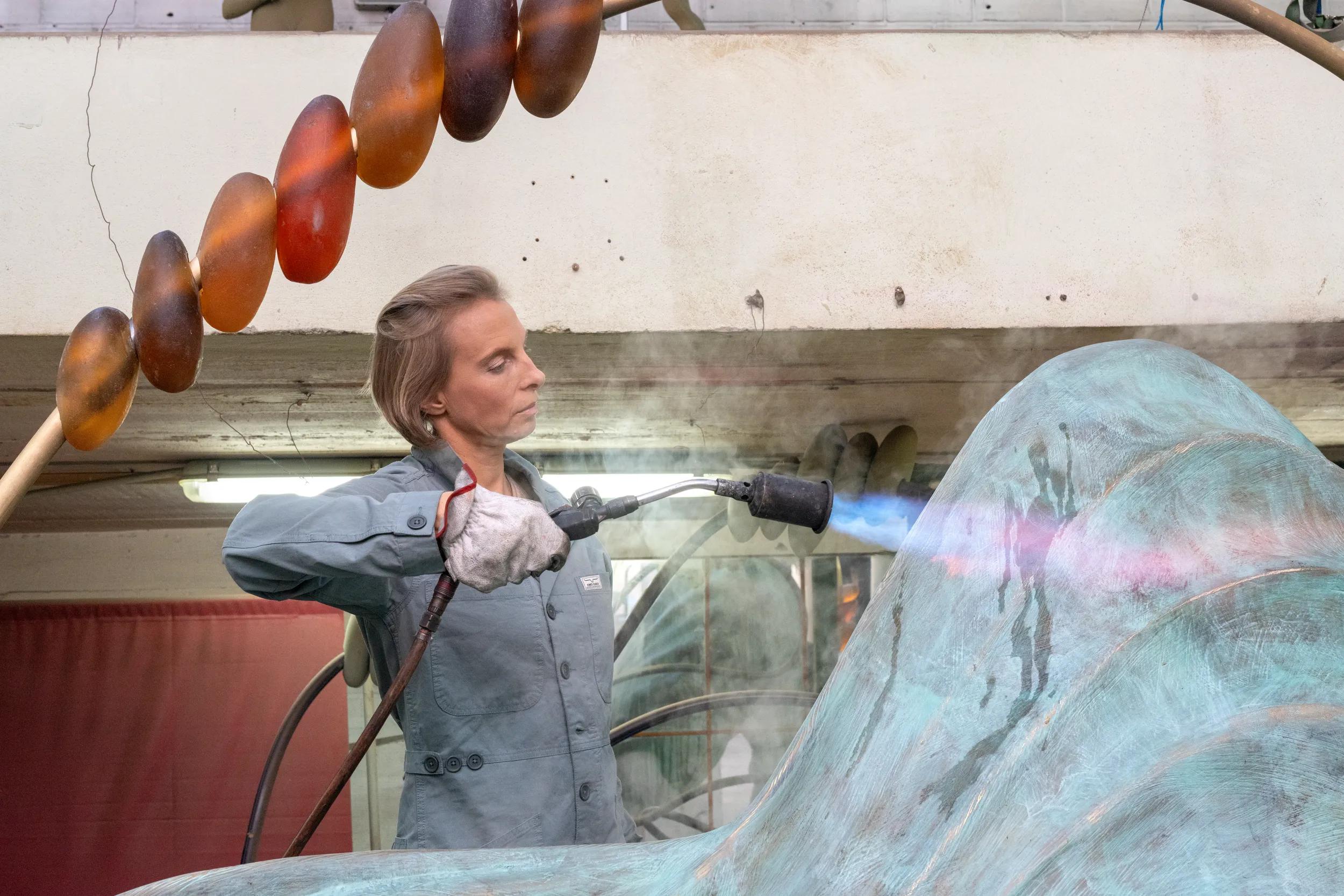
Camille Henrot
Born in 1978 in Paris, France, the artist lives and works in New York City.
The practice of French artist Camille Henrot moves seamlessly between film, painting, drawing, bronze, sculpture, and installation. Henrot draws upon references from literature, psychoanalysis, social media, cultural anthropology, self-help, and the banality of everyday life in order to question what it means to be both a private individual and a global subject.
A 2013 fellowship at the Smithsonian Institute resulted in her film ‘Grosse Fatigue,’ for which she was awarded the Silver Lion at the 55th Venice Biennale. She elaborated ideas from ‘Grosse Fatigue’ to conceive her acclaimed 2014 installation ‘The Pale Fox’ at Chisenhale Gallery in London. The exhibit, which displayed the breadth of her diverse output, went on to travel to institutions including Kunsthal Charlottenburg, Copenhagen; Bétonsalon – Centre for art and research, Paris; Westfälischer Kunstverein, Münster, Germany; and Tokyo Opera City Art Gallery, Japan. In 2017, Henrot was given carte blanche at Palais de Tokyo in Paris, where she presented the major exhibition ‘Days Are Dogs,’ She is the recipient of the 2014 Nam June Paik Award and the 2015 Edvard Munch Award, and has participated in the Lyon, Berlin, Sydney and Liverpool Biennials, among others.
Henrot has had numerous solo exhibitions worldwide, including the Middelheim Museum, Belgium; National Gallery of Victoria, Melbourne; New Museum, New York; Schinkel Pavilion, Berlin; New Orleans Museum of Art; Fondazione Memmo, Rome; Tokyo Opera City Art Gallery, Japan, among others.

Rashid Johnson
Born in Chicago in 1977, Rashid Johnson is among an influential cadre of contemporary American artists whose work employs a wide range of media to explore themes of art history, individual and shared cultural identities, personal narratives, literature, philosophy, materiality, and critical history. Johnson received a BA in Photography from Columbia College in Chicago and studied for his masters at the School of the Art Institute of Chicago. Johnson's practice quickly expanded to embrace a wide range of media—including sculpture, painting, drawing, film making, and installation—yielding a complex multidisciplinary practice that incorporates diverse materials rich with symbolism and personal history. Johnsons work is known for its narrative embedding of a pointed range of everyday materials and objects, often associated with his childhood and frequently referencing aspects of history and cultural identity. Many of Johnson’s more recent works delve into existential themes such as personal and collective anxiety, interiority, and liminal space.
Recent solo exhibitions include: ‘Rashid Johnson: A Poem for Deep Thinkers’, Guggenheim Museum, New York NY, 2025; ‘Seven Rooms and a Garden. Rashid Johnson + Moderna Museet’, Moderna Museet, Stockholm, Sweden, 2023; ‘Rashid Johnson. Nudiustertian’, Hauser & Wirth, Hong Kong, 2023; ‘The Chorus’, The Metropolitan Opera, New York NY, 2021; ‘Summer Projects. Rashid Johnson’, Creative Time, New York, NY, 2021; ‘Rashid Johnson. Capsule’, National Gallery of Canada, Ottawa, Canada, 2021; ‘The Crisis’, Storm King Art Center, New Windsor NY; ‘Rashid Johnson. Waves’, Hauser & Wirth, London, UK, 2020; the touring exhibition ‘Rashid Johnson. The Hikers’ at the Aspen Art Museum, Aspen CO, the Museo Tamayo, Mexico City, Mexico and at Hauser & Wirth, New York, 2019; ‘Provocations. Rashid Johnson’, Institute for Contemporary Art, Richmond VA, 2018; ‘Rashid Johnson. No More Water’ at Lismore Castle Arts, Lismore, Ireland, 2018 and ‘Rashid Johnson. Hail We Now Sing Joy’ at The Kemper Museum of Contemporary Art, Kansas City MO which traveled to the Milwaukee Art Museum, Milwaukee WI, 2017.

William Kentridge
William Kentridge is internationally acclaimed for his artworks, theater and opera productions. His method combines drawing and erasing, tearing, gestural painting, collage, weaving, casting, writing, film, performance, music, theater and collaborative practices to create works of art that are grounded in politics, science, literature and history, yet maintain a space for contradiction and uncertainty.
Born in 1955 in Johannesburg, South Africa, where he currently lives and works, Kentridge grew up under the pall of apartheid. His practice has parsed and questioned the historical record—responding to the past as it ineluctably shapes the present—and created a world within his art that both mirrors and shadows the inequities and absurdities of our own. By employing varied mediums, Kentridge seeks to construct meaning through the use of historical resources, including maps, language and everyday imagery, while always maintaining a space for contradiction and uncertainty.
Kentridge’s work has been seen in museums and galleries around the world since his first survey exhibition in 1998 at Palais des Beaux Arts, Brussels, including the Albertina Museum (Vienna), Castello di Rivoli Museo d’Arte Contemporanea (Turin), Johannesburg Art Gallery, Kunstmuseum Basel, Louisiana Museum (Humlebaek), Musée du Louvre (Paris), Museum of Modern Art (New York), Museum of Contemporary Art Sydney, Museo Nacional Centro de Arte Reina Sofía (Madrid), Norval Foundation (Cape Town), Royal Academy of Arts (London), Whitechapel Gallery (London) and Zeitz Museum of Contemporary Art Africa (Cape Town). He has participated a number of times in documenta (Kassel) (2012, 2002, 1997) and the Venice Biennale (2015, 2013, 2005, 1999), as well as the Sydney Biennale (2008) and the Istanbul Biennale (1995, 2015).
Kentridge’s opera productions began in 2005 with Mozart’s ‘The Magic Flute,’ which embarked on an international tour of opera houses after opening at La Monnaie in Brussels, Belgium. Subsequent productions include Shostakovich’s ‘The Nose’ and Alban Berg’s operas ‘Lulu’ and ‘Wozzeck,’ and have been seen at opera houses including the Metropolitan Opera (New York), La Scala (Milan), English National Opera (London), Opera de Lyon, Amsterdam Opera, the Sydney Opera House, as well as the KUNSTENFESTIVALDESARTS (Brussels) and the Salzburger Festspiele. Kentridge’s film, ‘Oh To Believe in Another World,’ made to accompany the performance of Shostakovich’s 10th Symphony, premiered at KKL Luzern in 2022 and has since been performed in theaters and at festivals worldwide.
Kentridge’s theatrical productions, performed in theatres and at festivals across the globe, include ‘Waiting for the Sibyl’ (2019), ‘The Head & the Load’ (2018), ‘Ursonate’ (2017), ‘Winterreise’ (2014), ‘Paper Music’ (2014), ‘Refuse the Hour’ (2011) and, in collaboration with the Handspring Puppet Company, ‘Il Ritorno d’Ulisse’ (1998), ‘Ubu & the Truth Commission’ (1997), ‘Faustus in Africa!’ (1995) and ‘Woyzeck on the Highveld’ (1992).
In 2016, Kentridge founded the Centre for the Less Good Idea in Johannesburg: a space for responsive thinking and making through experimental, collaborative and cross-disciplinary arts practices. The center hosts an ongoing program of workshops, public performances and mentorship activities.
Kentridge is the recipient of honorary doctorates from several universities including Yale, University of London and Columbia University. In 2010, he received the Kyoto Prize. In 2012, he was awarded the Commandeur dans l’ordre des Arts et des Lettres in France and he presented the Charles Eliot Norton Lectures at Harvard University. In 2015, he was appointed an Honorary Academician of the Royal Academy in London. In 2017, he received the Princesa de Asturias Award for the arts and, in 2018, the Antonio Feltrinelli International Prize. In 2019, he received the Praemium Imperiale award in painting in Tokyo. In 2021, he was made a Foreign Associate Member to the French Académie des Beaux Arts, Paris. In 2022, he was presented the Ordine della Stella d’Italia and, in 2023, he received the Olivier Award for Outstanding Achievement in Opera in London. As the Slade Professor of Fine Art for 2023/2024, Kentridge delivered a series of six lectures at the University of Oxford in January and February 2024.
His work can be found in the collections of public and private museums including Amorepacific Museum of Art (Seoul), Art Gallery of Western Australia (Perth), Art Institute of Chicago, Broad Art Foundation (Los Angeles), Carnegie Museum of Art (Pittsburgh), Castello di Rivoli Museo d’Arte Contemporanea (Turin), Centre Pompidou (Paris), Fondation Cartier (Paris), Fondation Louis Vuitton (Paris), Fundaçion Sorigue (Lerida), Guggenheim Abu Dhabi, Haus der Kunst (Munich), ICA Boston, Israel Museum (Jerusalem), JAG (Johannesburg), Kunsthalle Mannheim, Kunsthalle Praha (Prague), Kunstmuseum Basel, LACMA (Los Angeles), Louisiana Museum (Humlebaek), Luma Foundation (Arles), MAC (Montreal), MAXXI (Rome), Moderna Museet (Stockholm), MoCA (Los Angeles), MUDAM (Luxembourg), MoMA (New York), Museum of Fine Arts (Budapest), National Gallery of Australia (Canberra), National Gallery of Canada (Ottawa), National Museum of Modern Art (Kyoto), National Gallery of Victoria (Melbourne), Norval Foundation (Cape Town), San Diego Museum of Art, SFMoMA (San Francisco), Sharjah Art Foundation, Sifang Art Museum (Nanjing), Stedelijk Museum (Amsterdam), Tate (London), Vehbi Koç Foundation (Istanbul) and Zeitz MOCAA (Cape Town), as well as private collections worldwide.
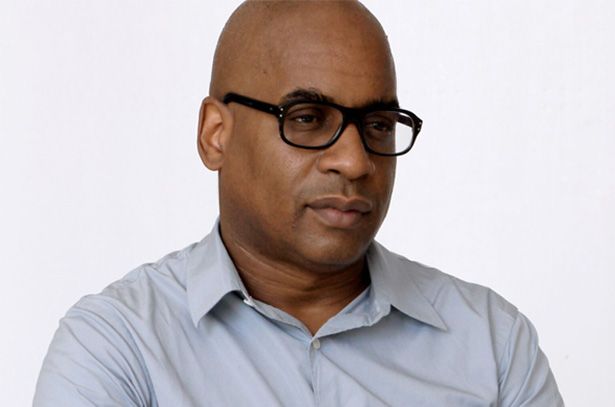
Glenn Ligon
Glenn Ligon (b. 1960) is an artist living and working in New York. Throughout his career, Ligon has pursued an incisive exploration of American history, literature and society across bodies of work that build critically on the legacies of modern painting and conceptual art. He earned his BA from Wesleyan University (1982) and attended the Whitney Museum Independent Study Program (1985). In 2011, the Whitney Museum of American Art held a mid-career retrospective, ‘Glenn Ligon: AMERICA,’ organized by Scott Rothkopf, that traveled nationally. Important solo exhibitions include ‘Post-Noir,’ Carre d’Art, Nîmes (2022); ‘Glenn Ligon: Call and Response,’ Camden Arts Centre, London, UK (2014); and ‘Glenn Ligon – Some Changes,’ The Power Plant Center for Contemporary Art, Toronto, Canada and then traveled internationally (2005). Select curatorial projects include ‘Grief and Grievance,’ New Museum, New York NY (2021); ‘Blue Black,’ Pulitzer Arts Foundation, St. Louis MO (2017); and ‘Glenn Ligon: Encounters and Collisions,’ Nottingham Contemporary and Tate Liverpool, UK (2015). Ligon’s work has been shown in major international exhibitions, including the Venice Biennale (2015, 1997), Berlin Biennial (2014), Istanbul Biennial (2019, 2011) and Documenta XI (2002).
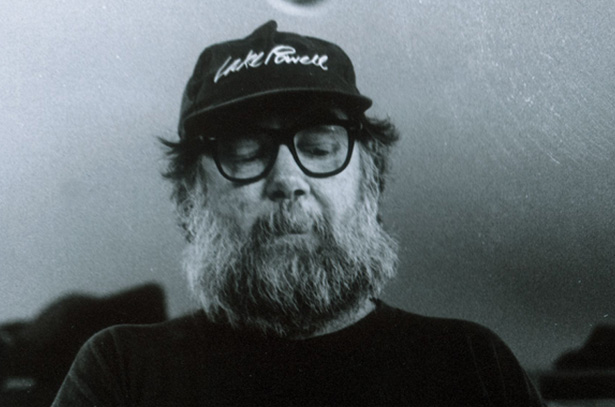
PAUL McCARTHY
Paul McCarthy is widely considered to be one of the most influential and groundbreaking contemporary American artists. Born in 1945, and raised in Salt Lake City, Utah, he first established a multi-faceted artistic practice, which sought to break the limitations of painting by using unorthodox materials such as bodily fluids and food. He has since become known for visceral, often hauntingly humorous work in a variety of mediums—from performance, photography, film and video, to sculpture, drawing and painting.
During the 1990s, he extended his practice into installations and stand-alone sculptural figures, utilizing a range of materials such as fiberglass, silicone, animatronics and inflatable vinyl. Playing on popular illusions and cultural myths, fantasy and reality collide in a delirious yet poignant exploration of the subconscious, in works that simultaneously challenge the viewer’s phenomenological expectations.
Whether absent or present, the human figure has been a constant in his work, either through the artist‘s own performances or the array of characters he creates to mix high and low culture, and provoke an analysis of our fundamental beliefs. These playfully oversized characters and objects critique the worlds from which they are drawn: Hollywood, politics, philosophy, science, art, literature, and television. McCarthy’s work, thus, locates the traumas lurking behind the stage set of the American Dream and identifies their counterparts in the art historical canon.
McCarthy earned a BFA in painting from the San Francisco Art Institute in 1969, and an MFA in multimedia, film and art from USC in 1973. For 18 years, he taught performance, video, installation, and art history in the New Genres Department at UCLA, where he influenced future generations of west coast artists and he has exhibited extensively worldwide. McCarthy’s work comprises collaborations with artist-friends such as Mike Kelley and Jason Rhoades, as well as his son Damon McCarthy.
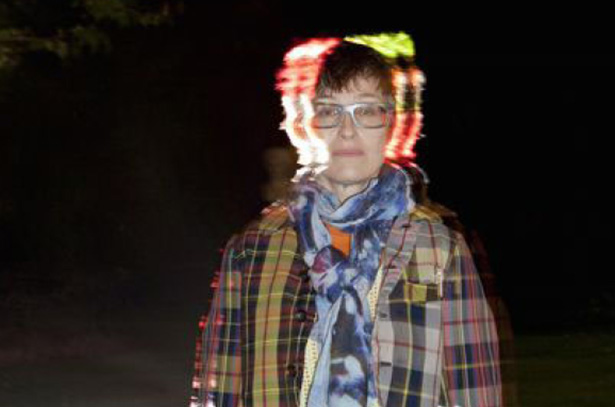
Pipilotti Rist
Pipilotti Rist, a pioneer of spatial video art, was born 1962 in Grabs in the Swiss Rhine Valley on the Austrian Border and has been a central figure within the international art scene since the mid-1980s.
Astounding the art world with the energetic exorcistic statement of her now famous single channel videos, such as ‘I’m Not The Girl Who Misses Much,’ 1986 and ‘Pickelporno,’ 1992, her artistic work has co-developed with technical advancements and in playful exploration of its new possibilities to propose footage resembling a collective brain. Through large video projections and digital manipulation, she has developed immersive installations that draw life from slow caressing showers of vivid color tones, like her works ‘Sip My Ocean,’ 1996 or ‘Worry Will Vanish,’ 2014.
For Rist, showing vulnerability is a sign of strength on which she draws for inspiration. With her curious and lavish recordings of nature (to which humans belong as an animal), and her investigative editing, Rist seeks to justify the privileged position we are born with, simply by being human. Her installations and exhibition concepts are expansive, finding within the mind, senses and body the possibility for endless discovery and poetical invention. ‘Pixel Forest,’ 2016, made from 3,000 thousand LEDs hung on strings, resembles a movie screen that has exploded into the room, allowing viewers an immersive walk through 3-dimensional video. As she herself puts it, ‘beside the energy-intensive exploration of the geographical world, pictures, films and sounds have been and are the spaces into which we can escape... The projector is the flamethrower, the space is the vortex and you are the pearl within.’
Since 1984, Rist has had countless solo and group exhibitions, and video screenings worldwide. Her recent solo exhibitions are 'Electric Idyll' at the Fire Station Doha (2024), 'Prickling Goosebumps & A Humming Horizon' at Hauser & Wirth New York and Luhring Augustine Chelsea (2023-24), 'Behind Your Eyelid' at Tai Kwun Hong Kong (2022), ‘Big Heartedness, Be My Neighbor’ at The Geffen Contemporary, MOCA, Museum of Contemporary Art Los Angeles (2021 – 2022), ‘Your Eye Is My Island’ at MoMAK, The National Museum of Modern Art Kyoto and ART TOWER MITO (2021). ‘Åbn min Lysning. Open my Glade’ at Louisiana Museum of Modern Art Humlebæk Denmark (2019), ‘Sip My Ocean’ at the Museum of Contemporary Art Sydney (2017 – 2018), ‘Pixel Forest’ at New Museum New York (2016 – 2017) and ‘Your Saliva is My Diving Suit of the Ocean of Pain’ at Kunsthaus Zürich (2016), all resulted in record-breaking attendance numbers for each institution. A major exhibition is planned for summer 2025 at UCCA Beijing.
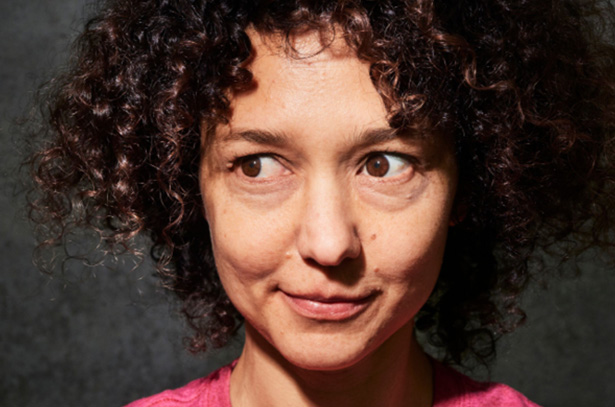
Mika Rottenberg
Argentina-born, New York-based artist Mika Rottenberg is devoted to a rigorous practice that combines film, architectural installation, and sculpture to explore ideas of labor and the production of value in our contemporary hyper-capitalist world.
Using traditions of both cinema and sculpture, she seeks out locations around the world where specific systems of production and commerce are in place, such as a pearl factory in China, and a Calexico border town. Through the editing process, and with footage from sets built in her studio, Rottenberg connects seemingly disparate places and things to create elaborate and subversive visual narratives. By weaving fact and fiction together, she highlights the inherent beauty and absurdity of our contemporary existence.
Each of Rottenberg’s video works is situated within a theatrical installation, made up of objects from the parallel worlds in her videos. Sacks of pearls, deflated pool toys, plastic flowers and sizzling frying pans seem to open a portal into the realm of the work. Her multidimensional film projects are often accompanied by standalone sculptural works, connected by allegory.
Rottenberg’s most recent body of work, “Lampshares” (2023–present), is a ‘mini circular economy’ that produces functional sculptures made from invasive vines and reclaimed plastic. The artist and her team collect, mold, extrude and press NYC street waste plastic and bittersweet vines from NY forests into sculptural and functional form—suggesting the artist’s studio can be an incubator for a restorative circle of creation and consumption.
Rottenberg’s latest feature length film, ‘REMOTE’ (2022), co-created with Mahyad Tousi, was commissioned by Artangel, United Kingdom; the Louisiana Museum, Humlebaek; and Moderna Museet, Stockholm; and premiered at Tate Modern and the New York Film Festival in 2022.
Rottenberg earned her BA from the School of Visual Arts in New York and followed this with an MFA at Columbia University in 2004. Rottenberg was the recipient of the 2019 Kurt Schwitters Prize, which recognizes artists who have made a significant contribution to the field of contemporary art. In 2018, she was the winner of the Smithsonian American Art Museum’s James Dicke Contemporary Artist Prize, which recognizes an artist younger than 50 who has produced a significant body of work and consistently demonstrates exceptional creativity.
Rottenberg’s work is held in numerous major museum and public collections including the Brooklyn Museum, Brooklyn NY; Institute of Contemporary Art, Boston MA; Hirshhorn Museum and Sculpture Garden, Washington DC; Louisiana Museum of Modern Art, Humlebæk, Denmark; The Metropolitan Museum of Art, New York NY; The Museum of Modern Art, New York NY; San Francisco Museum of Modern Art, San Francisco CA; Solomon R. Guggenheim Museum, New York NY; Moderna Museet, Stockholm, Sweden; Tate, London, United Kingdom; and the Whitney Museum of American Art, New York NY. Her work has been exhibited at major institutions including the Museum of Modern Art, New York NY; Venice Biennale (2015); and National Museum of Modern and Contemporary Art, Seoul, Korea. She has had solo exhibitions at the Louisiana Museum of Modern Art, Humlebæk, Denmark; New Museum, New York NY; Palais de Tokyo, Paris, France; Goldsmiths Centre for Contemporary Art, London, United Kingdom; and Museum of Contemporary Art Chicago, Chicago IL among others.
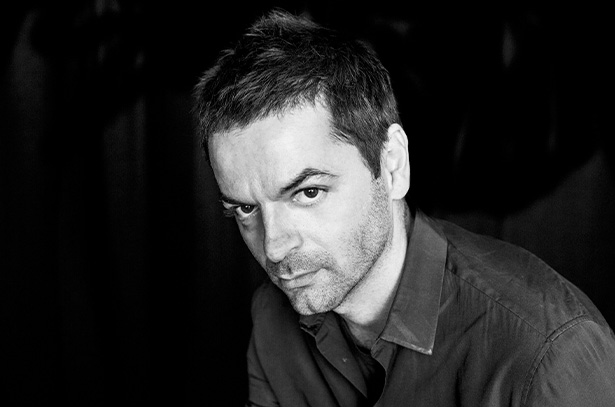
Anri Sala
Anri Sala represents a truly contemporary international vision: working in a range of media including video, photography and installation, Sala was educated in Albania and France, but now lives and works in Berlin. In his films and installations, Sala invites viewers to participate in his world of cultural observation, for which he often uses socio-political settings and personal experiences as backdrops.
By juxtaposing elements of past and present, discordance and harmony, and by overlapping narrative, sound and movement, Sala creates a unique sensibility. With his first critically acclaimed experimental documentary ‘Intervista (Finding the words)’ from 1998, the artist formulates his interest in perception of reality, truth and historical transformation. Since then, his practice emerged into a study of sound—soundtracks of images, the absence of sound, or the failure of verbal communication, all form distinct kinds of narratives.
In 2001, Sala was the recipient of the Young Artist Prize at the Venice Biennale and in 2013, he exhibited his acclaimed video works ‘Ravel Ravel’ and ‘Unravel’(both 2013) for the French Pavilion. Both works analyze the perception of space through music—two versions of Ravel’s ‘Piano Concerto for the Left hand in D-major’ can be seen performed alongside each other. ‘Unravel’ sets out to sync what deliberately was paced out of sync; Chloé, a DJ and music producer, can be observed standing in the middle of the German pavilion trying to untangle what has been entangled in ‘Ravel Ravel.'
The undercurrent of Sala’s projects, such as ‘Intervista (Finding Words)’ or ‘Ravel Ravel Unravel,’ is a fundamentally personal exploration of intimate, interwoven stories, resonating themes of a changing society and the individual. The artist’s interest in transition and rupture is demonstrated by the way in which he relates language, sound, music. The impact of his work featured at the world's top venues and exhibitions endorses Sala’s conviction that art can transcend cultural references without losing any of its specificity, nor indeed, its power.
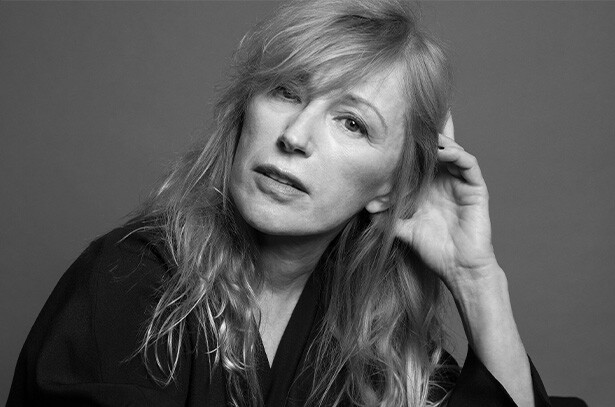
Cindy Sherman
Cindy Sherman was born in 1954 in Glen Ridge, New Jersey; she lives and works in New York. Her ground-breaking photographs have interrogated themes around representation and identity in contemporary media for over four decades. Sherman first turned her attention to photography at Buffalo State College, where she studied art in the early 1970s, and came to prominence in the late 1970s with the Pictures Generation group.
Utilising prosthetics, theatrical effects, photographic techniques and digital technologies, she has channeled and reconstructed familiar personas known to the collective psyche, often in unsettling ways, and has explored the more grotesque aspects of humanity through the lens of horror and the abject. Her later series have also touched on issues from class to aging.
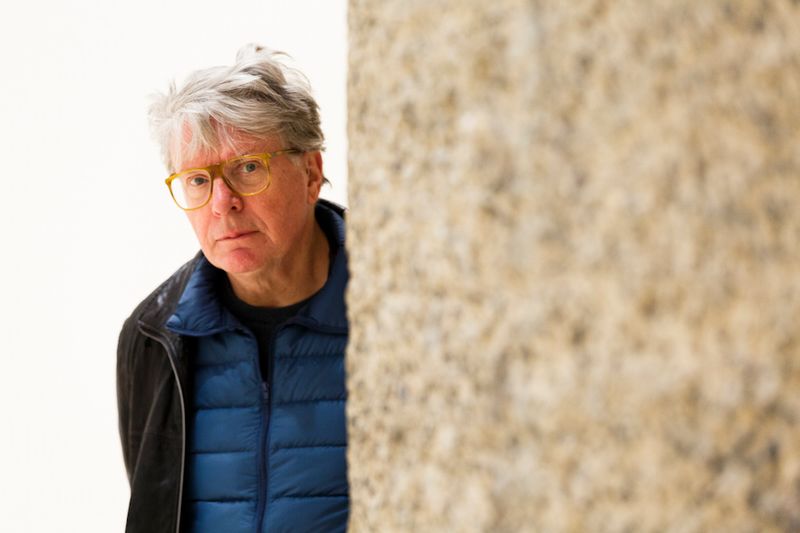
Roman Signer
Swiss artist Roman Signer has been redefining sculpture for more than 40 years and is now regarded as one of the finest representatives of Process and Conceptual art. He produces elementary dynamic sculptures and installations, also known as time sculptures for their preoccupation with the transformation of materials and objects through time. In his actions, acceleration and change are part of the creative process and he uses photography and moving image to document his work.Characterized by processes and potentialities, his work takes into account the concepts of Minimalism and Conceptualism, and with this Signer occupies a unique position in the recent history of sculpture. Signer exploits the possible uses and limitations of everyday objects, such as umbrellas, bottles, tables, chairs and candles, through a process guided by both curiosity and discipline. Like the director of a thriller, he makes use of tension and surprise—with the distinction that in his case everything takes place in the here and now. The works are the direct result of processes initiated by the artist.
Signer’s work explores the relationships between sudden energy releases and calm, between order and chaos, and the existence of form in the apparently formless. Physical forces like gravitation and motor energies are both a challenge to the artist and the instruments he relies on to realize his sculptural ideas. In his work, classical sculptural materials have been usurped by sand, water and ordinary objects. Meticulous planning and incalculable chance interact, generating ‘poetic’ visual installations with their own highly developed individual aesthetic. Signer’s artistic explorations of the world around us and its phenomena changes our perceptions and even seems to alter reality. Often the mere indication of a sudden or possible release of energy is enough to transmogrify a simple configuration of objects—a movable wooden arm and a rocket—into a wittily succinct visual commentary on the relationship between cause and effect.
His work has been presented in numerous museums and galleries worldwide and has been selected for prestigious international exhibitions such as the Venice Biennale, where he represented Switzerland in 1999, Skulptur Projekte Münster (1997) as well as Documenta 8 in Kassel where during ‘Action in front of the Orangerie’ he catapulted 350.000 sheets of paper into the air simultaneously with an explosive charge.

Gary Simmons
One of the foremost artists of a generation which emerged during the late 1980s and early 1990s, Gary Simmons has achieved wide acclaim over the past three decades for his work which explores the politics of race, class and social stereotypes through painting, sculpture, sound and architectural environments. Simmons uses imagery drawn from popular culture to create works that address personal and collective memories.
Born in New York in 1964, Simmons received his BFA from the School of Visual Arts in 1988, and his MFA from CalArts in 1990, studying under the tutelage of Charles Gaines, Michael Asher, Catherine Lord, and others. Early in his practice, Simmons established a studio in a former school in New York City. At this stage, he was working predominantly in sculpture, a medium he would return to in subsequent decades. Works from this period, such as ‘Big Dunce’ (1989), use schoolroom objects to address racial inequality and institutional racism through the filter of childhood experience, themes seen most explicitly in ‘Six-X’ (1989), comprising six child-sized Ku Klux Klan uniforms hanging from a schoolhouse coatrack.
Simmons’ use of pedagogical motifs, in particular readymade chalkboards, led to the formal and aesthetic breakthrough that would inform much of his subsequent work, in which erasure of the image has been a powerful and recurring theme. Outlines of characters, scenes and words—based on 20th-century cartoons steeped in the racist traditions of minstrelsy, disappeared architectural sites, vintage film title cards, evaporating clouds of smoke and stars—are drawn or painted then blurred and smeared by hand. The tropes of erasure and ephemerality suggest the fleeting nature of memory and histories re-written. As the artist explains: ‘I started to think about how images on blackboards can never be fully erased. It was about trying to erase a stereotype and the traces of the racial pain that you drag along with you.’ A landmark piece commissioned for the Whitney Biennial, ‘Wall of Eyes’ (1993), picturing a smudged field of cartoon eyes drawn with chalk over slate paint applied directly to the wall, revealed the aesthetic possibilities of chalkboard at a monumental scale.
In further key commissions, Simmons has expanded beyond the confines of museum and gallery walls, creating performative and site-specific works which underline a relationship to a trajectory of art history that includes minimalism and conceptual art. For ‘Sky Erasure Drawings’ (1996), commissioned by the Museum of Contemporary Art Chicago, airplanes temporarily inscribed vapor stars in the daytime sky using liquid paraffin. For his immersive installation, ‘Fade to Black’ (2017), for the California African American Museum in Los Angeles, Simmons created five monumental wall drawings featuring the titles of vintage silent films and the names of largely forgotten African American actors in big typewriter-style letters blurred with ghostly traces. In a series of works from 2019, Simmons mined the architecture of surveillance through depictions of watchtowers and lighthouses. Deliberately ambiguous, these works collapsed the boundaries between signifiers of safety and those of control.
Simmons’ immersion in music has continually informed his practice which draws inspiration from dub, punk, hip-hop, reggae, and rap. Particularly influenced by the genres’ race and class-focused politics, the artist has created a number of works tracing the voices in music that have shaped contemporary culture. Simmons attracted significant critical attention in 2014 for his stacked speaker piece ‘Recapturing Memories of the Black Ark’. Inspired by Jamaican sound systems, the work is a living sculpture, with performers invited to activate it and then leave the configuration they utilized behind until the next performance. The work’s ongoing history offers both a contrasting and complementary approach to the record of the past offered by the artist’s erasure paintings.
For a site-specific installation commissioned for Culture Lab Detroit in 2016, Simmons was inspired by the guerrilla marketing style of fly-posting to promote gigs. Using found posters sourced from flea markets and the internet, he manipulated the originals, saturating the colors or reworking the texts, before layering onto the wall. This process has subsequently made its way into other works on plywood and canvas that evoke the fragmentation between individual and collective memory that preoccupies much of Simmons’ practice.
In his most recent works, Simmons continues to engage with popular culture, however, in an increasingly nuanced and abstracted way, as his focus shifts towards the history and materiality of painting and sculpture. Simmons has also reintroduced racist cartoon characters such as Bosko and Honey from the Looney Toons franchise and the crows from Disney’s film, ‘Dumbo’. Combined with the use of erasure, the artist references the attempt to cover up the engrained prejudices revealed by the popularity of such cartoons. Though these subjects first appeared in Simmons chalkboard drawings from the early 1990s, his newest works demonstrate an exploration of painterly issues such as background, depth of field, process and layering, citing Albert Oehlen and Martin Kippenberger as influences. The process involves a constant building and removal of up to fifteen layers of paint, evoking layered histories lying deep beneath the canvas. Simmons likens this effect to aged chalkboards, containing the traces of years of markings.
Gary Simmons has been the subject of solo exhibitions both nationally and internationally, including Henry Art Gallery, Seattle; California African American Museum, Los Angeles; Modern Art Museum of Fort Worth; and Kunsthaus Zürich. Selected group exhibitions include Museum of Modern Art, New York; Walker Art Center, Minneapolis; and Stedelijk Museum, Amsterdam; among others. Simmons was featured in Thelma Golden’s landmark 1994 ‘Black Male’ exhibition at the Whitney Museum of American Art in New York, Franklin Sirmans’ 2014 Prospect Triennial in New Orleans, and Okwui Enwezor’s ‘All the World’s Futures,’ for the 2015 Venice Biennale.
In 2021, Simmons was appointed a National Academician by the National Academy of Design. He is the recipient of the Joyce Alexander Wein Prize, Studio Museum of Harlem; USA Gund Fellowship; Penny McCall Foundation Grant; National Endowment for the Arts Inter-Arts Grant; and the Aspen Award for Art.
The first comprehensive institutional survey of Simmons’ work, ‘Gary Simmons: Public Enemy,’ was on view at Museum of Contemporary Art Chicago in 2023 and traveled to Pérez Art Museum Miami from 2023 – 2024.

Lorna Simpson
Born in Brooklyn, Lorna Simpson came to prominence in the 1990s with her pioneering approach to conceptual photography. Simpson’s early work—particularly her striking juxtapositions of text and staged images—raised questions about the nature of representation, identity, gender, race and history that continue to drive the artist’s expanding and multi-disciplinary practice today. She deftly explores the medium’s umbilical relation to memory and history, both central themes within her work.
Studying on the West Coast in the mid-1980s, Simpson was part of a generation of artists who utilized conceptual approaches to undermine the credibility and apparent neutrality of language and images. Her most iconic works from this period depict African-American figures as seen only from behind or in fragments. Photographed in a neutral studio space, the figures are tied neither to a specific place nor time. Drawing upon a long-standing interest in poetry and literature, the artist accompanies these images with her own fragmented text, which is at times infused with the suggestion of violence or trauma. The incredibly powerful works entangle viewers into an equivocal web of meaning, with what is unseen and left unsaid as important as that which the artist does disclose. Seemingly straightforward, these works are in fact near-enigmas, as complex as the subject matter they take on.
Over the past 30 years, Simpson has continued to probe these questions while expanding her practice to encompass various media including film and video, painting, drawing and sculpture. Her recent works incorporate appropriated imagery from vintage Jet and Ebony magazines, found photo booth images, and discarded Associated Press photos of natural elements—particularly ice, a motif that appears in her sculptural work in the form of glistening ‘ice’ blocks made of glass. The new work continues to immerse viewers in layers of bewitching paradoxes, threading dichotomies of figuration and abstraction, past and present, destruction and creation, and male and female. Layered and multivalent, Simpson’s practice deploys metaphor, metonymy, and formal prowess to offer a potent response to American life today.
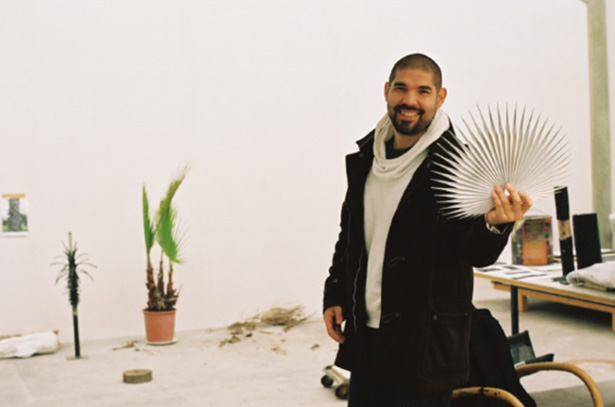
David Zink Yi
The oeuvre of the Berlin-based artist David Zink Yi revolves around themes of creation, manifestation, and the construction of identity. Born in Lima in 1973, Zink Yi left Peru for Germany at the age of 16. Drawing inspiration from his own experiences, he interrogates the complex aspects of identity construction through his multi-disciplinary practice; encompassing film, photography, sculpture, performance, ceramics and multi-channel video installations, which all emphasize the social interrelation of the protagonists, as well as physiological aspects of musical perception.
Zink Yi’s art has gained attention for its critical engagement with culturally and emotionally determined actions and experiences. These actions, such as cooking, speaking, dancing, singing, writing and narrating, sketch the complexity of identity, identity-formation and their forms of expression and are most often the performative stimulus for making the works. Over the past decades, the artist has been using natural forms, ritual, music and dance to explore the complex motifs as constructed within cultural traditions. As a medium of expression, the body is often present in the works. It is the place at which the limits between outward and inward experience, between factual history and personal feeling, are drawn.
Over the past few years, Zink Yi has worked within the ceramic tradition to create sculptural works inspired by different molluscs and cephalopods such as octopus fragments, squids and architeuthidae. These elusive animals, with a rich history in myth and fine art, are understood as a complex living species opposite to the human one.
Current Exhibitions
1 / 9


